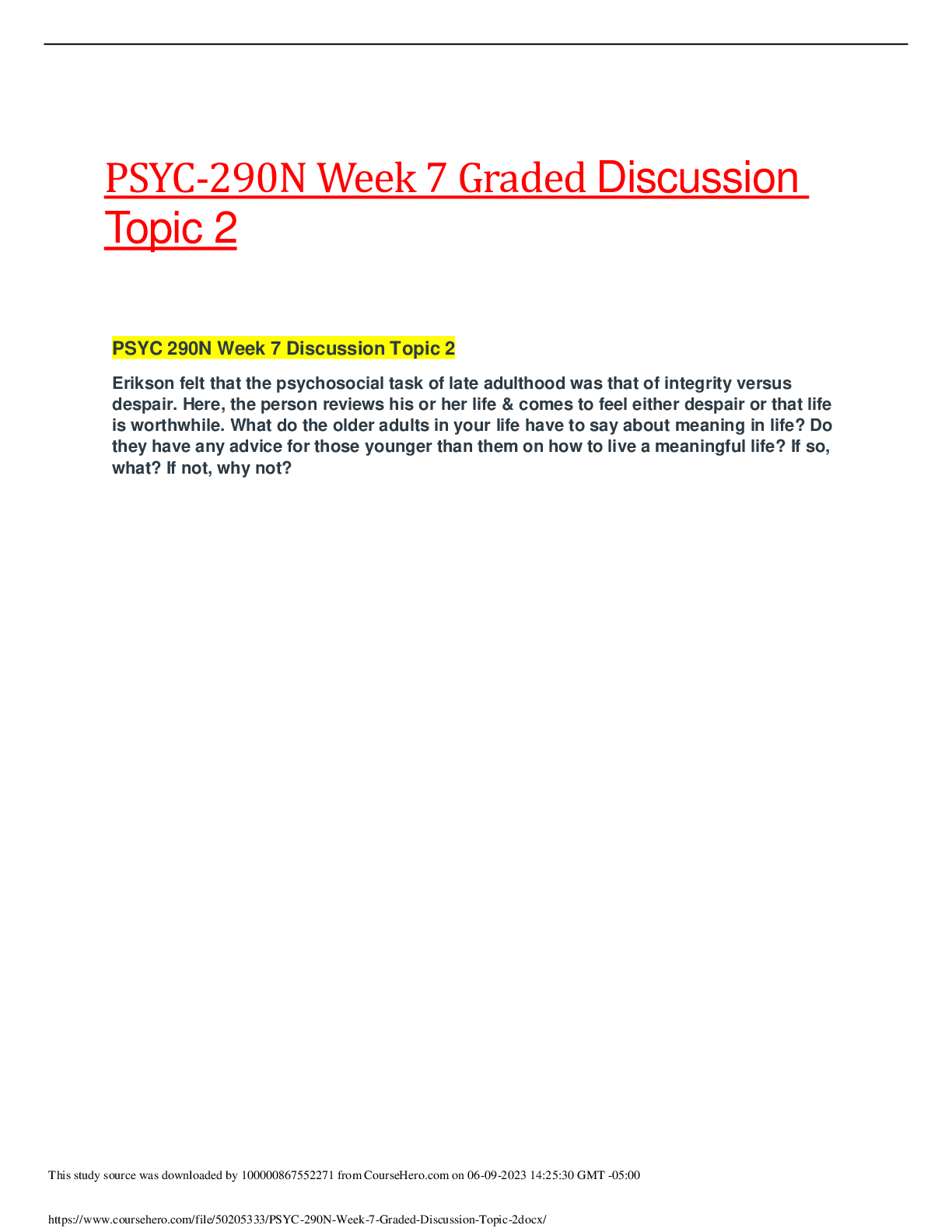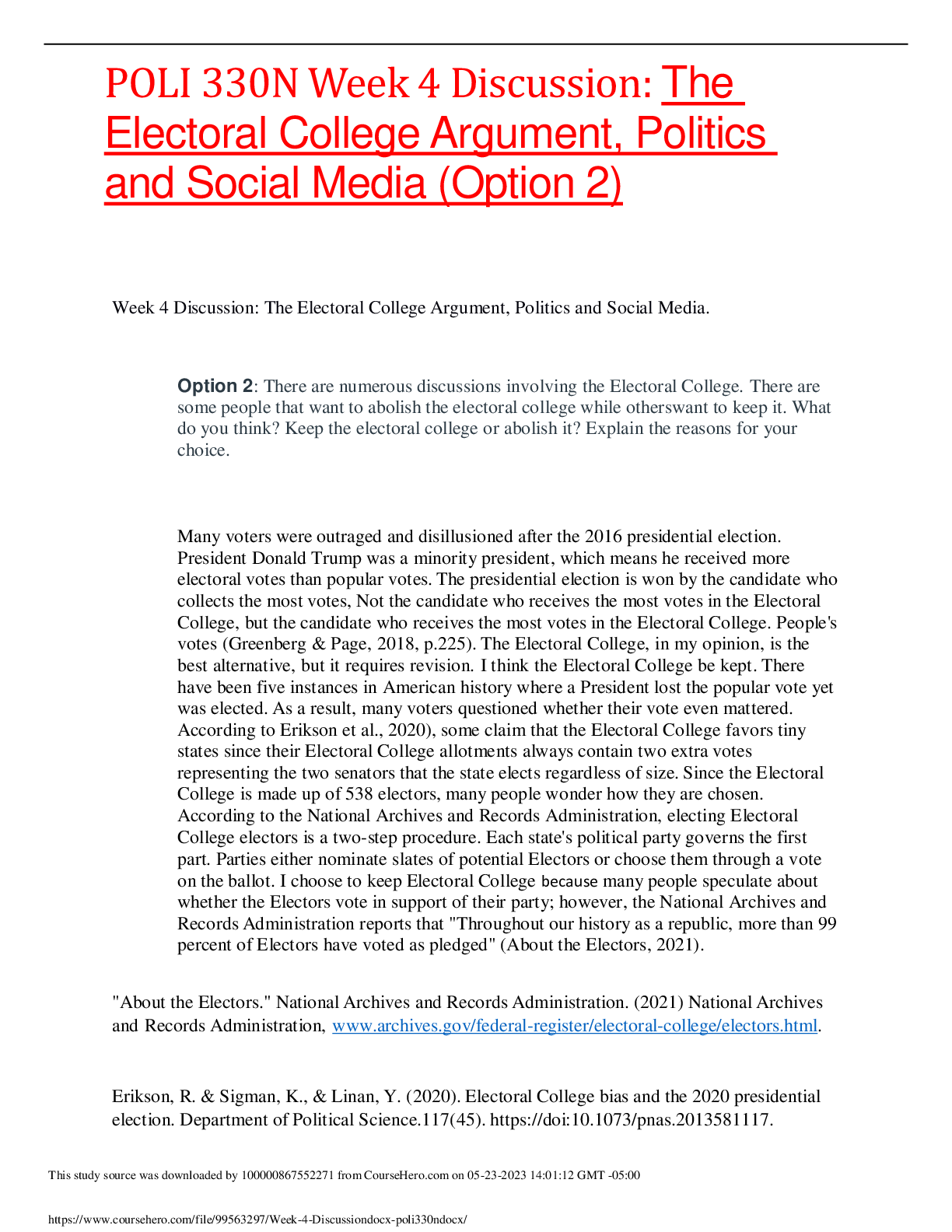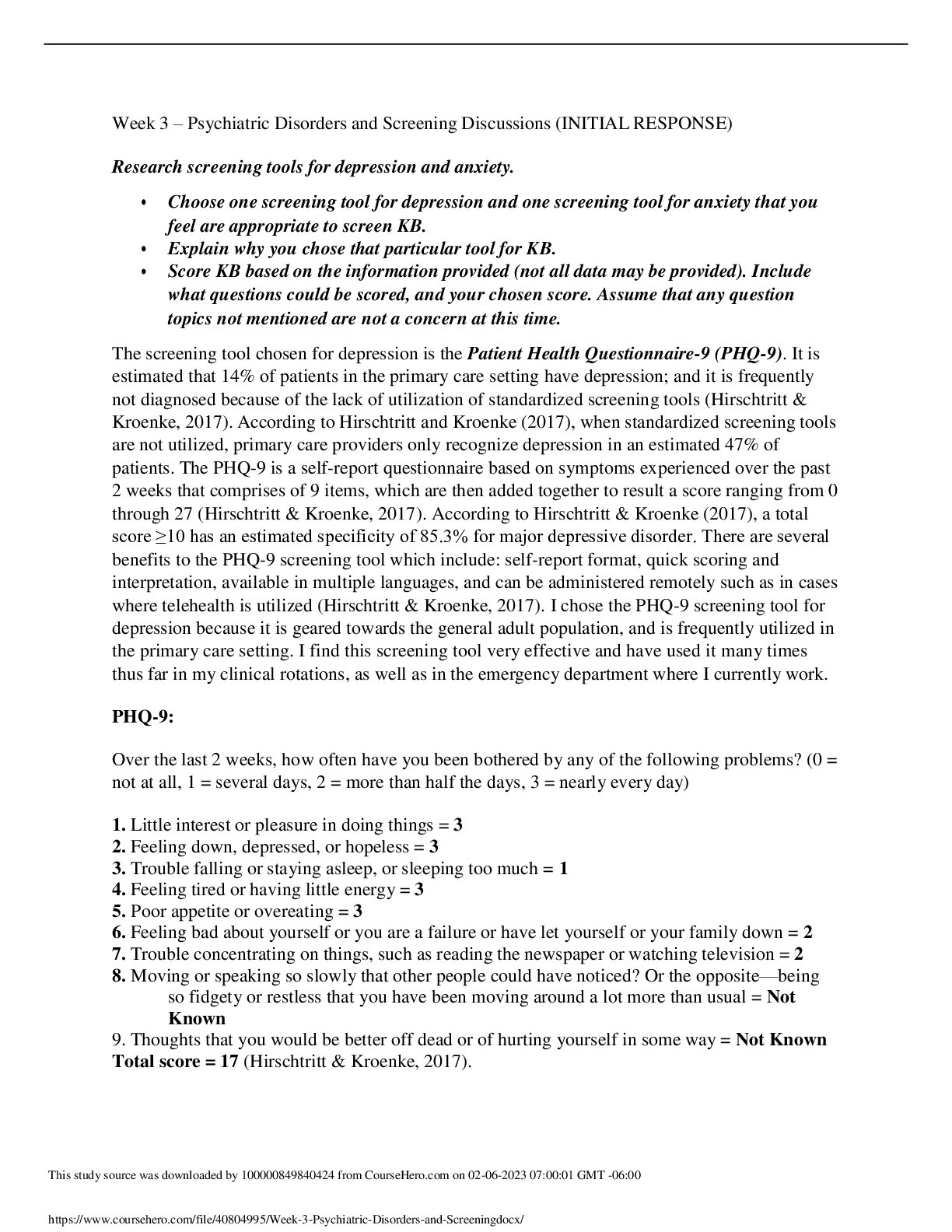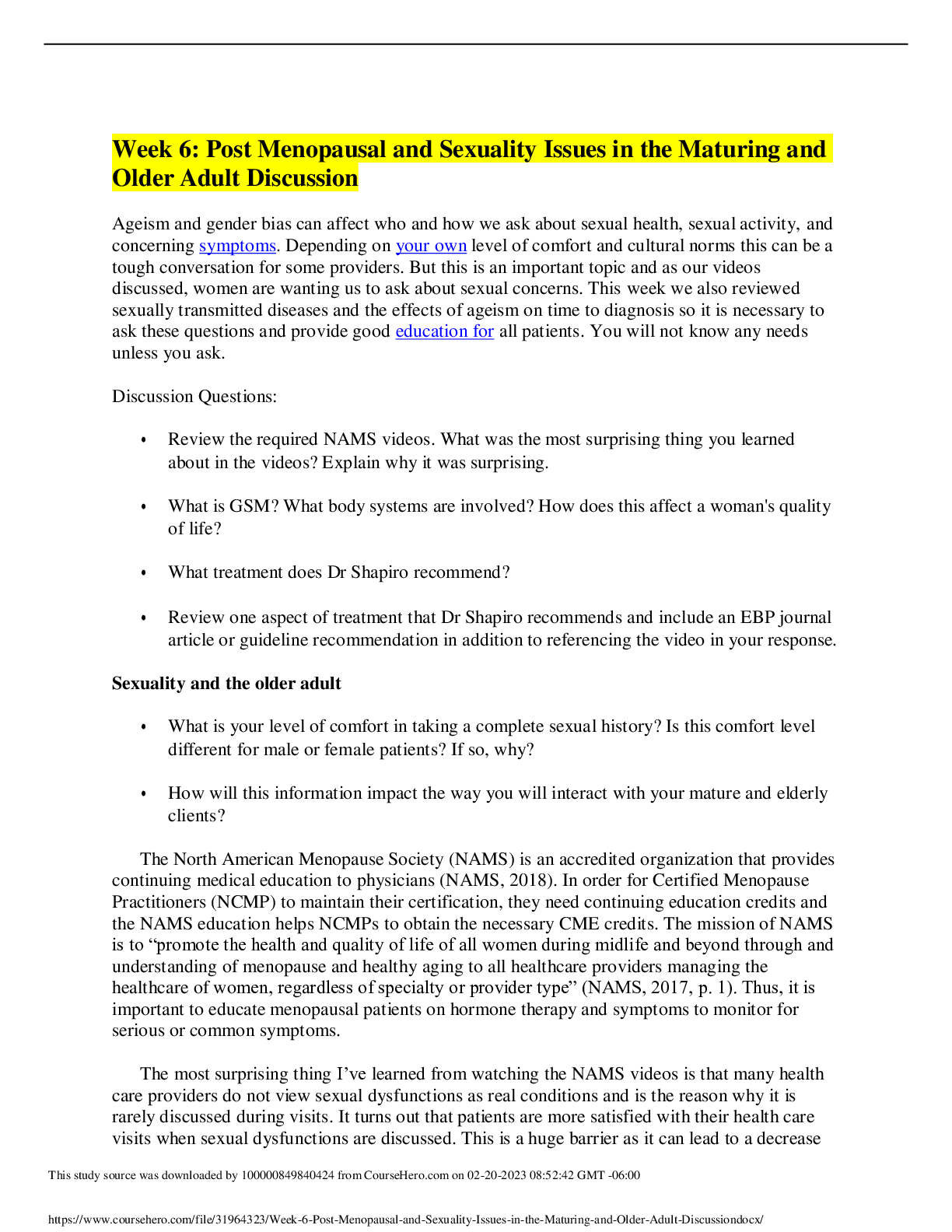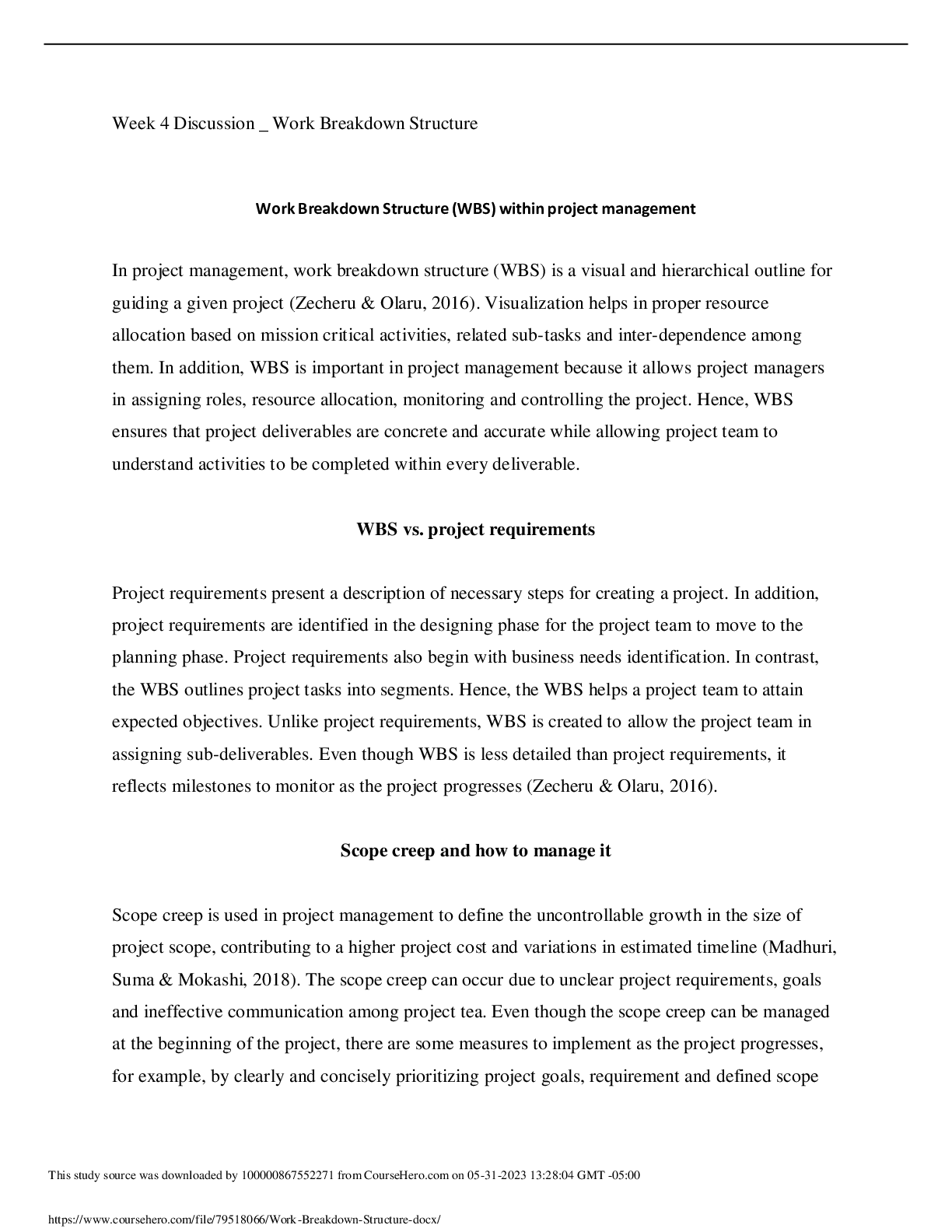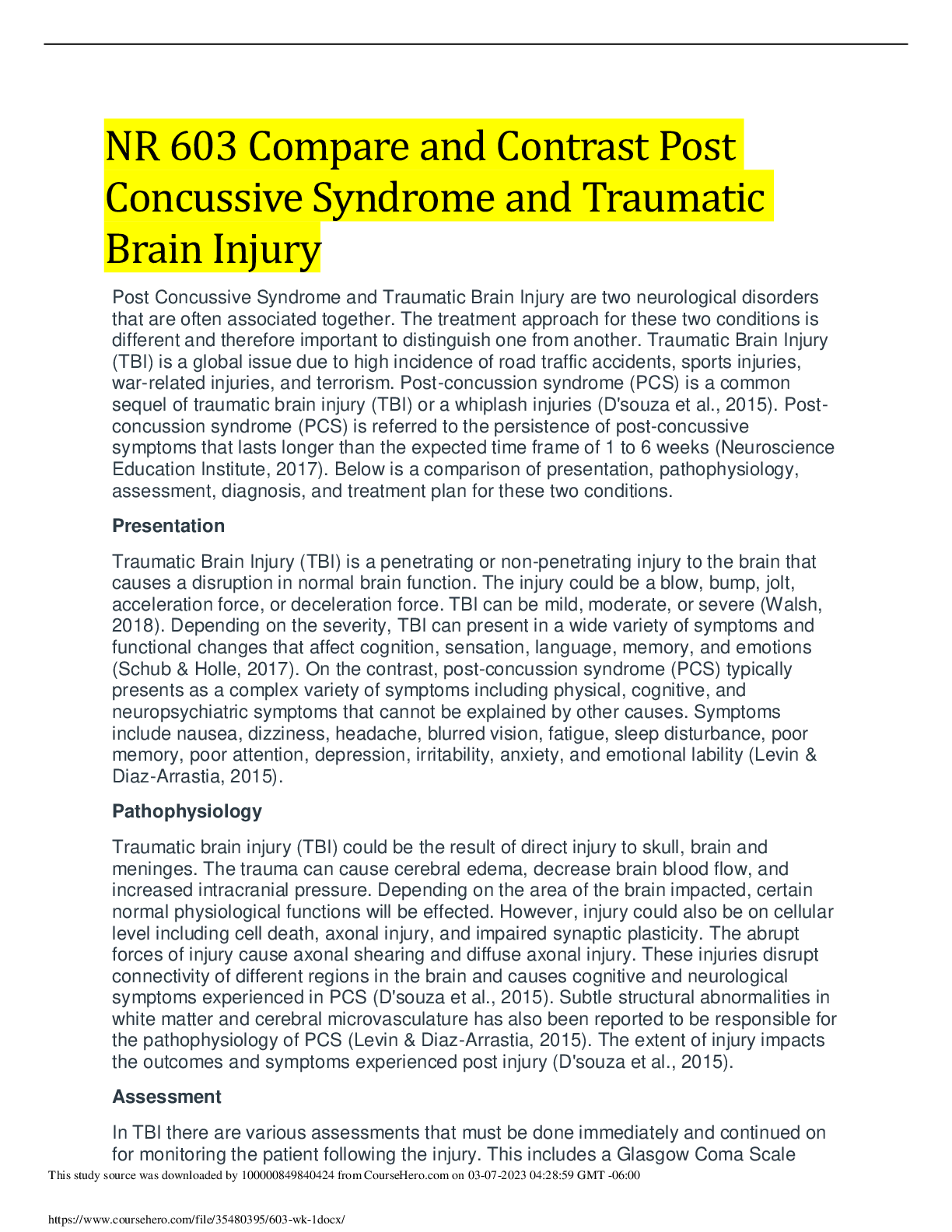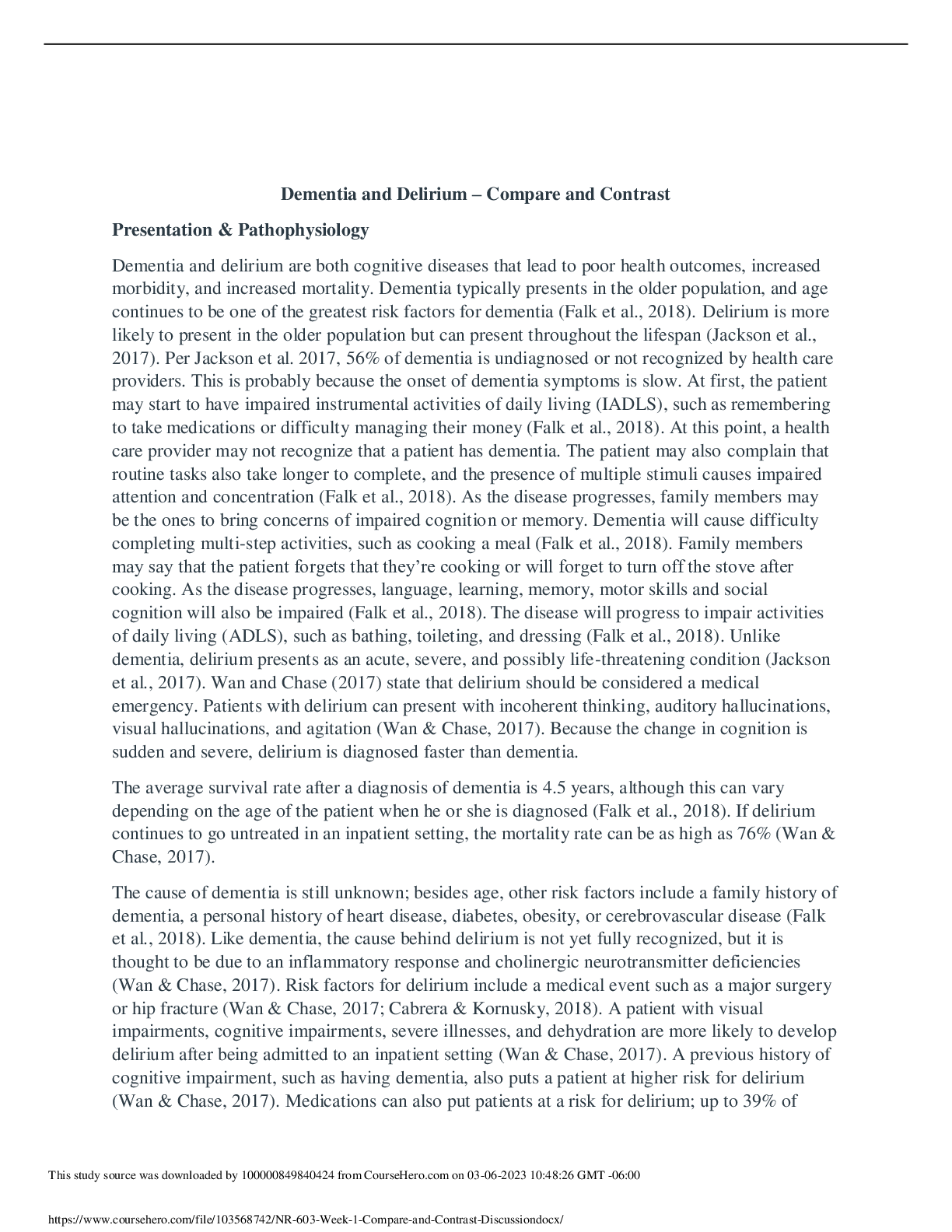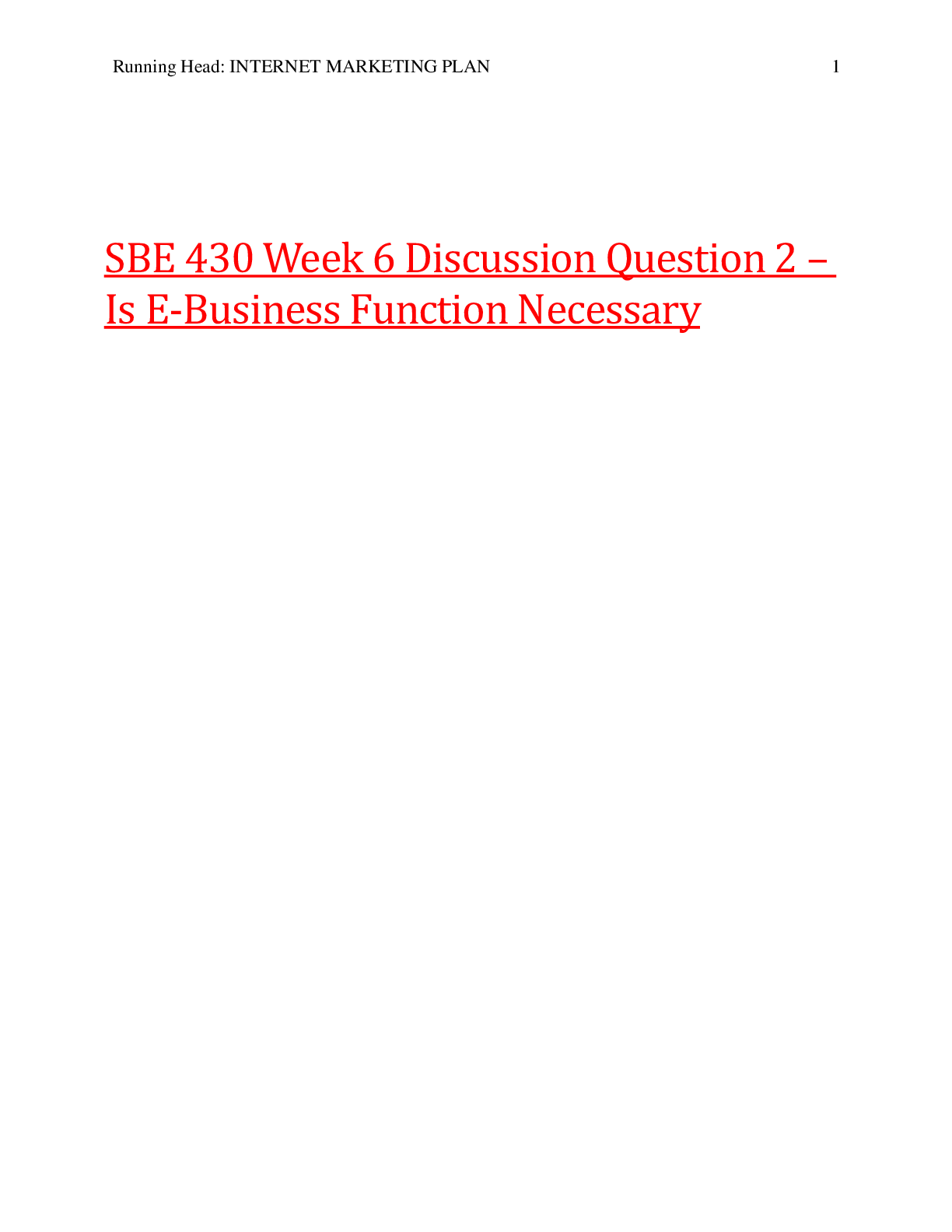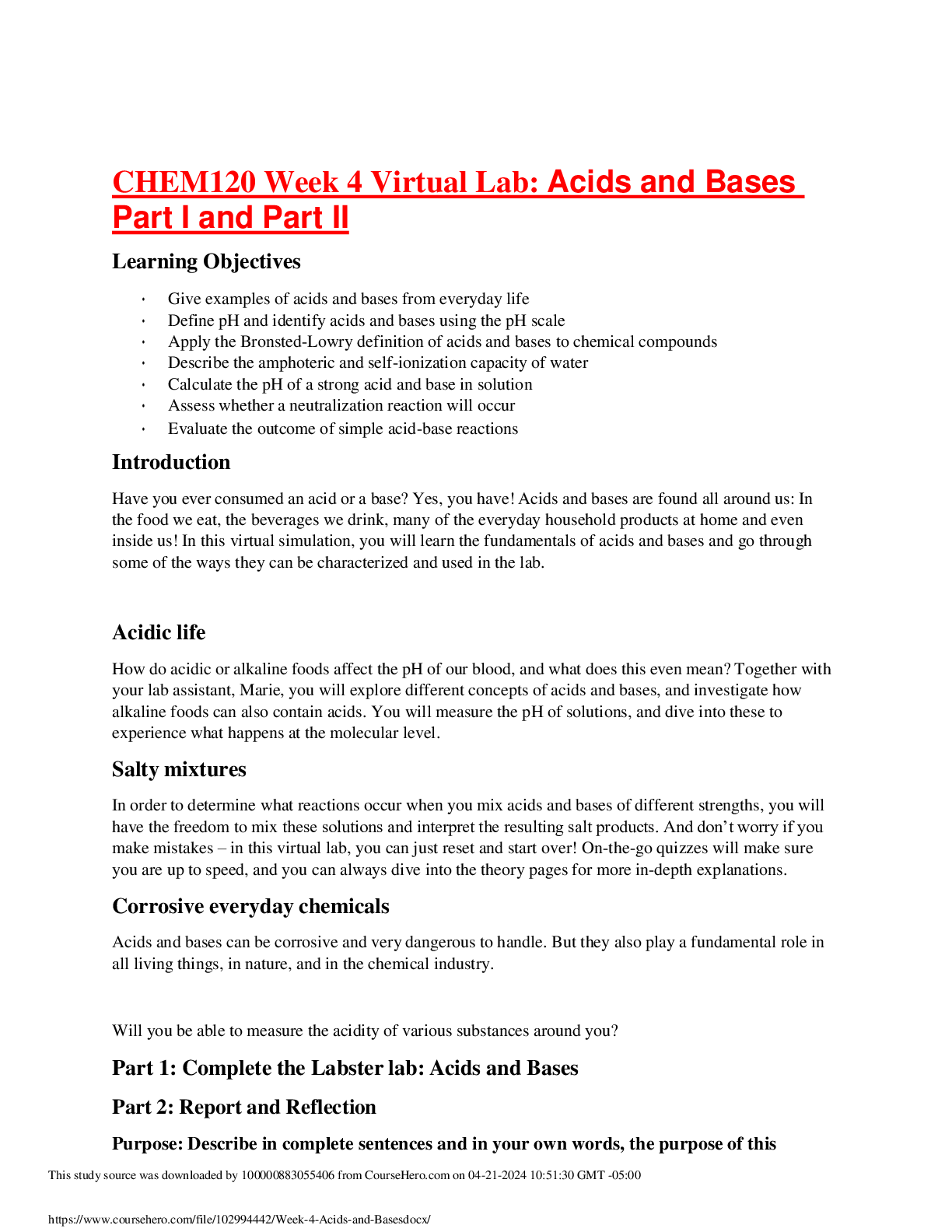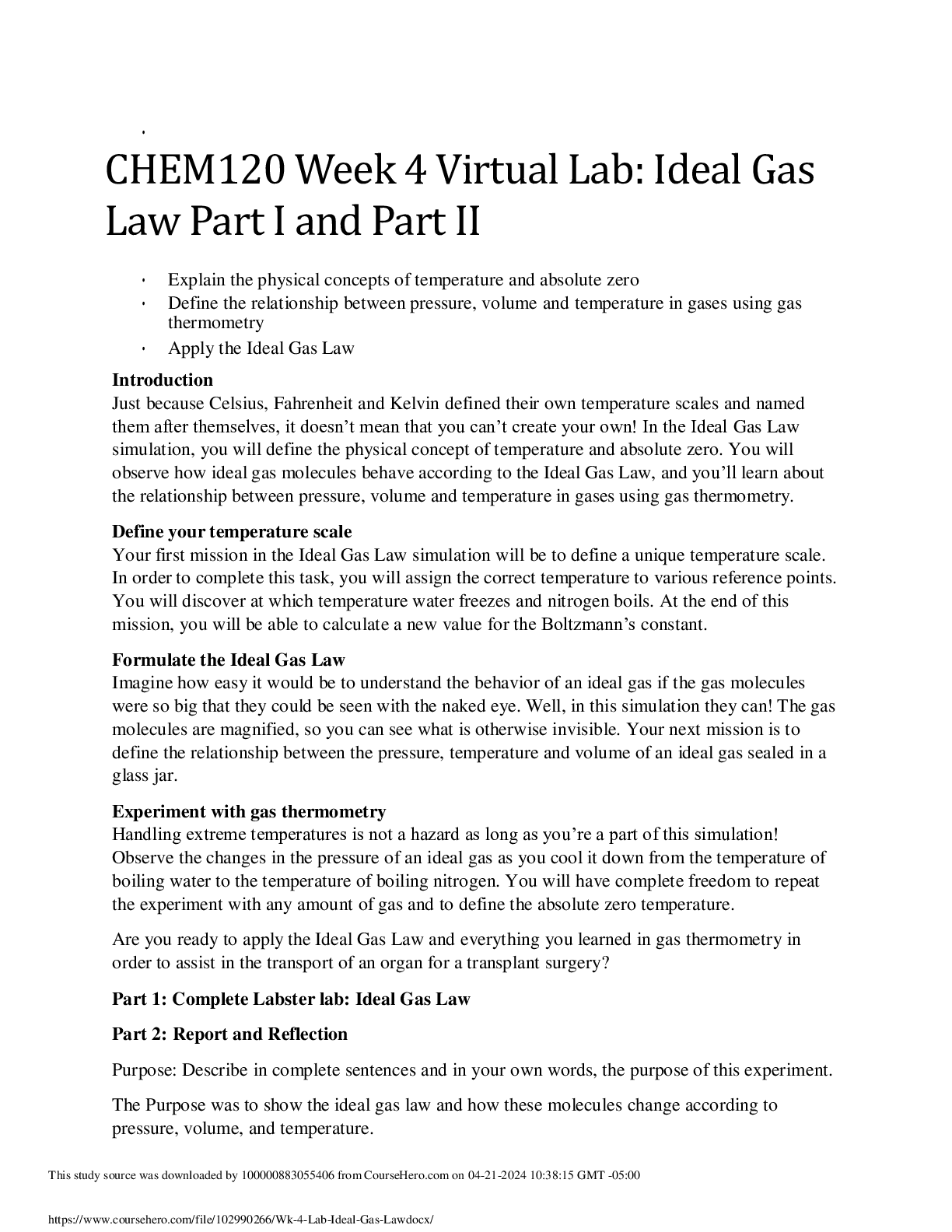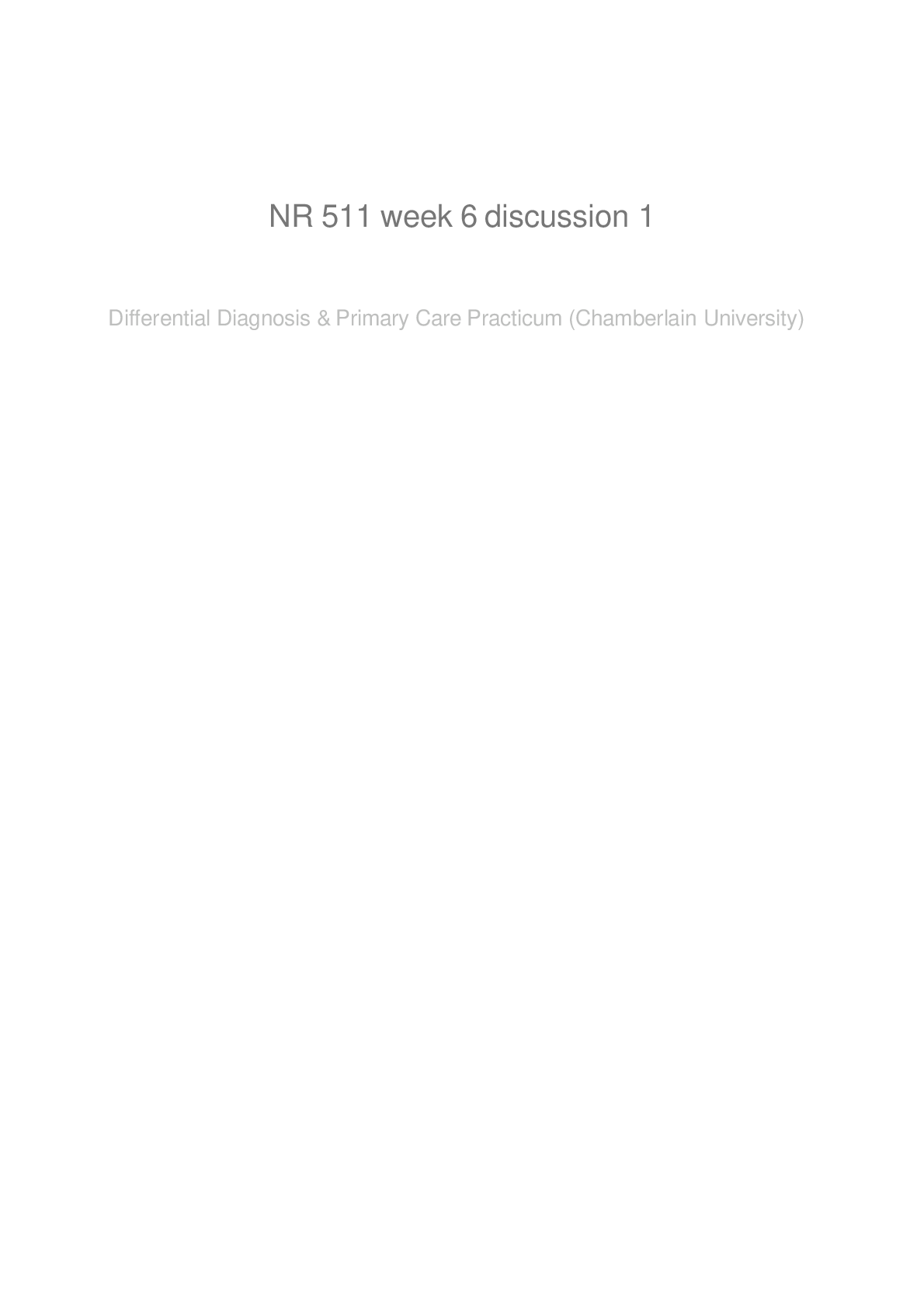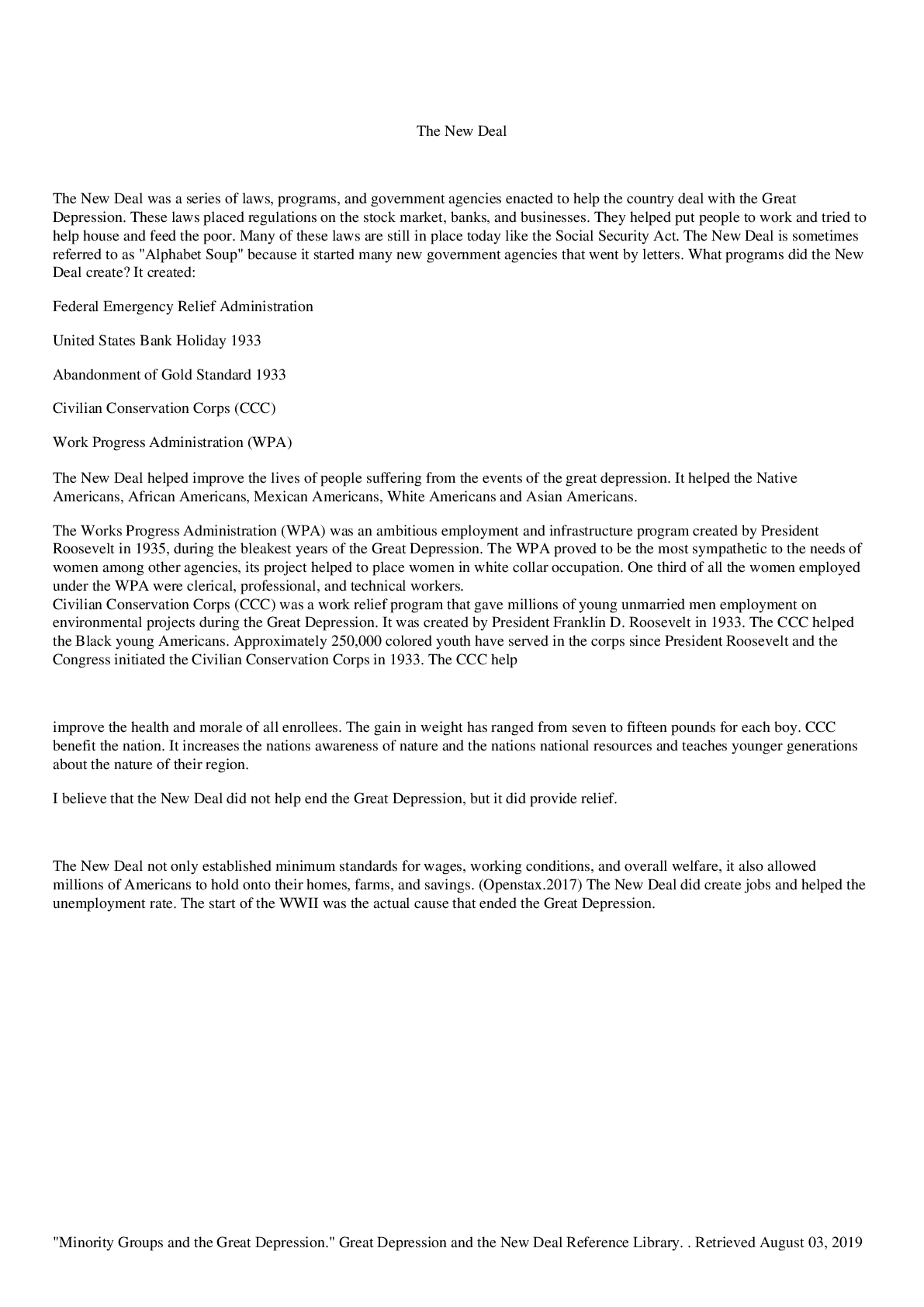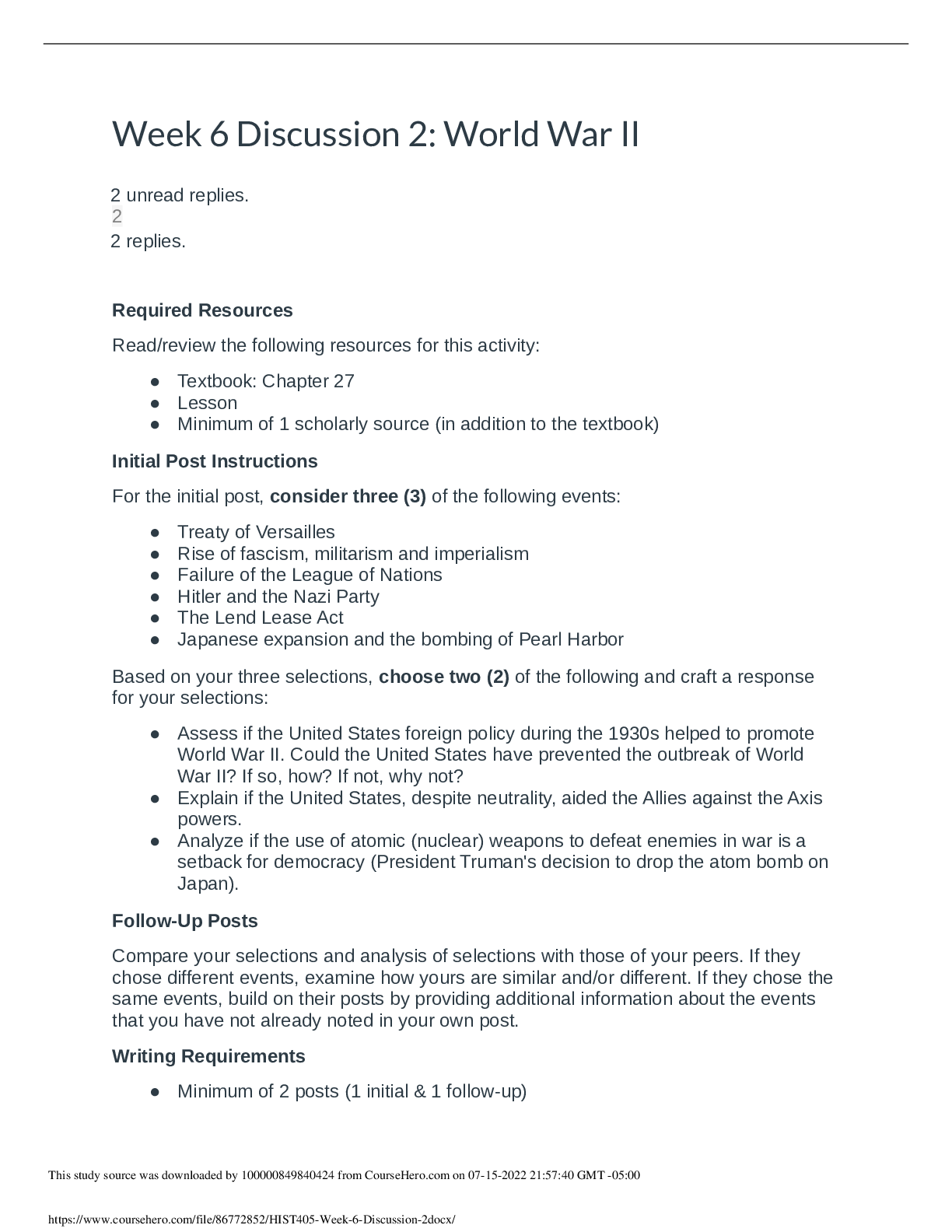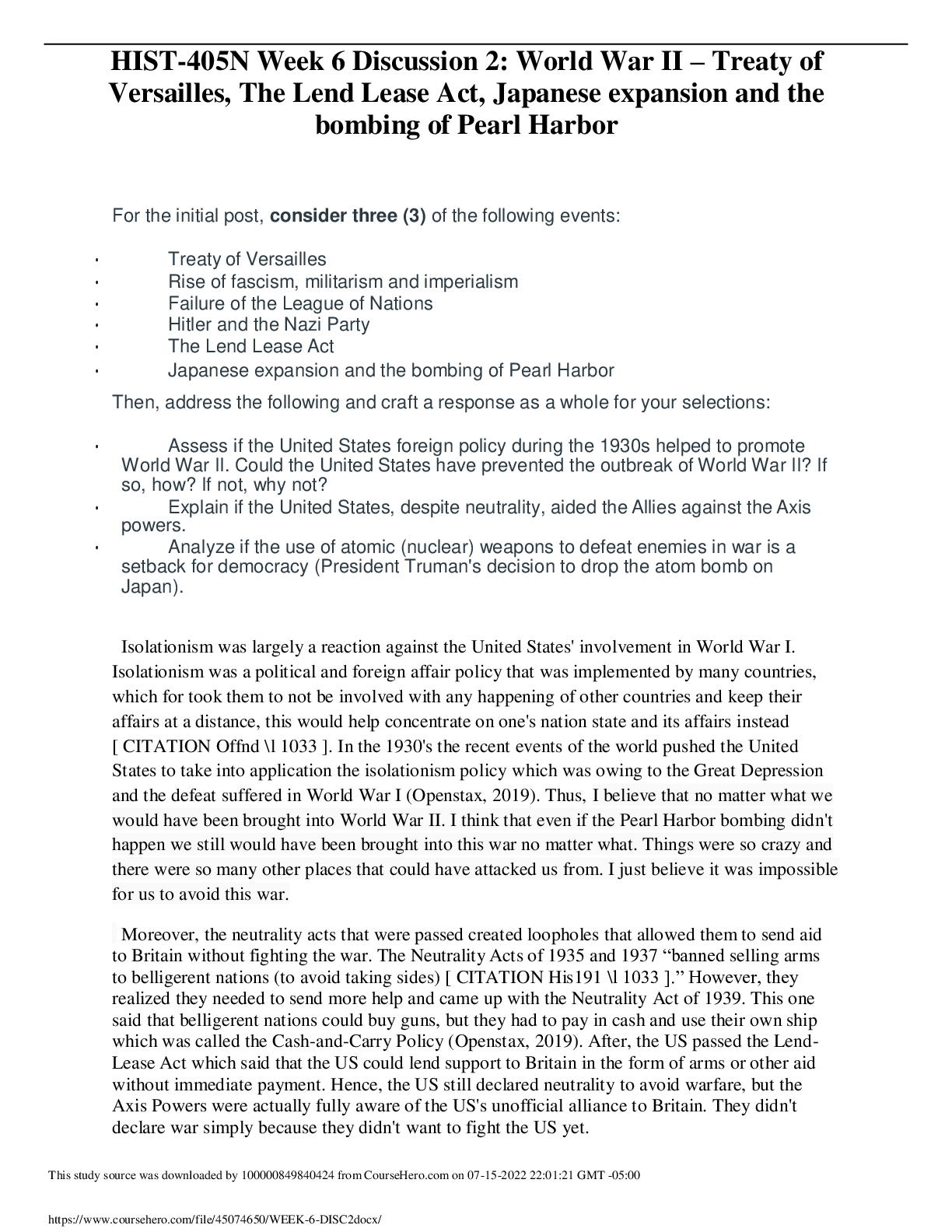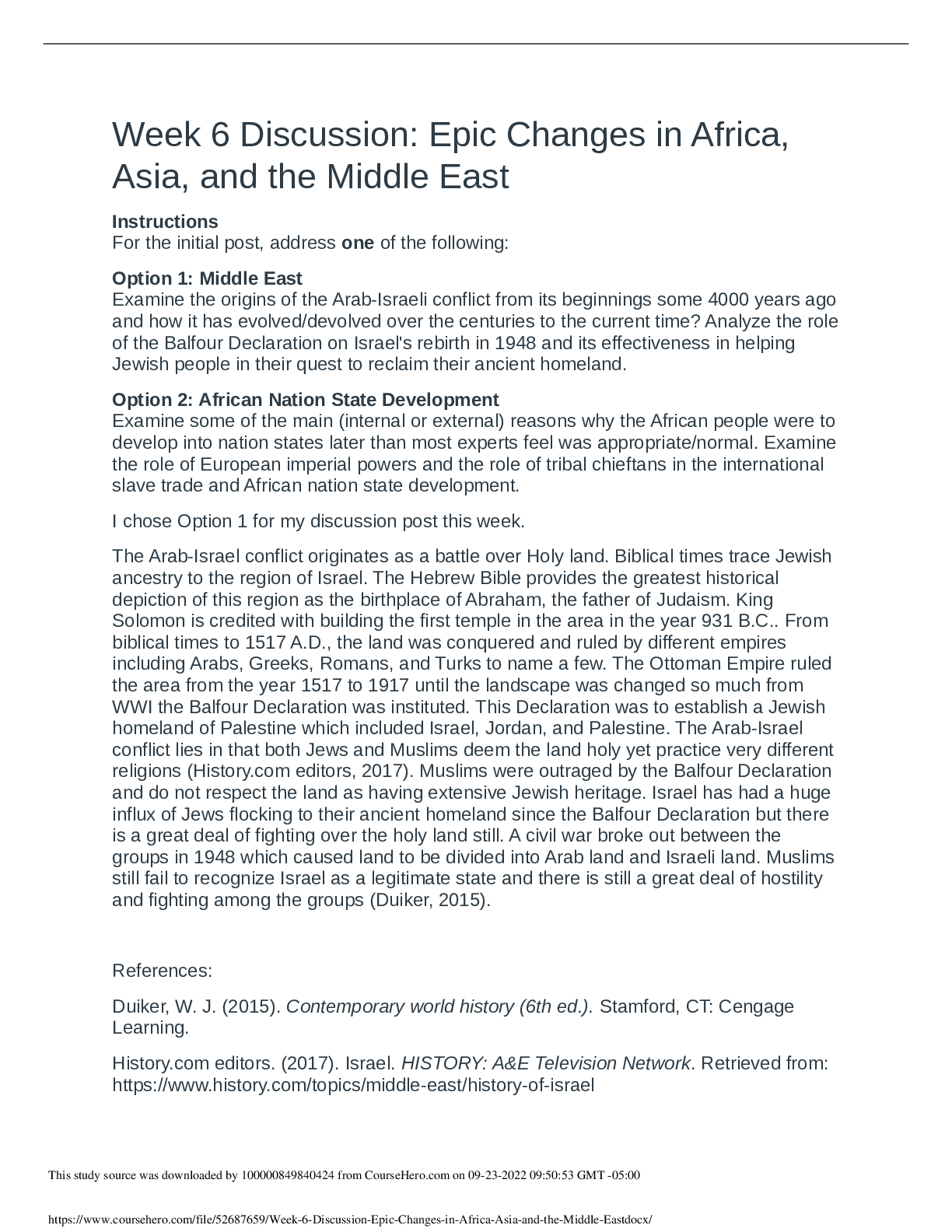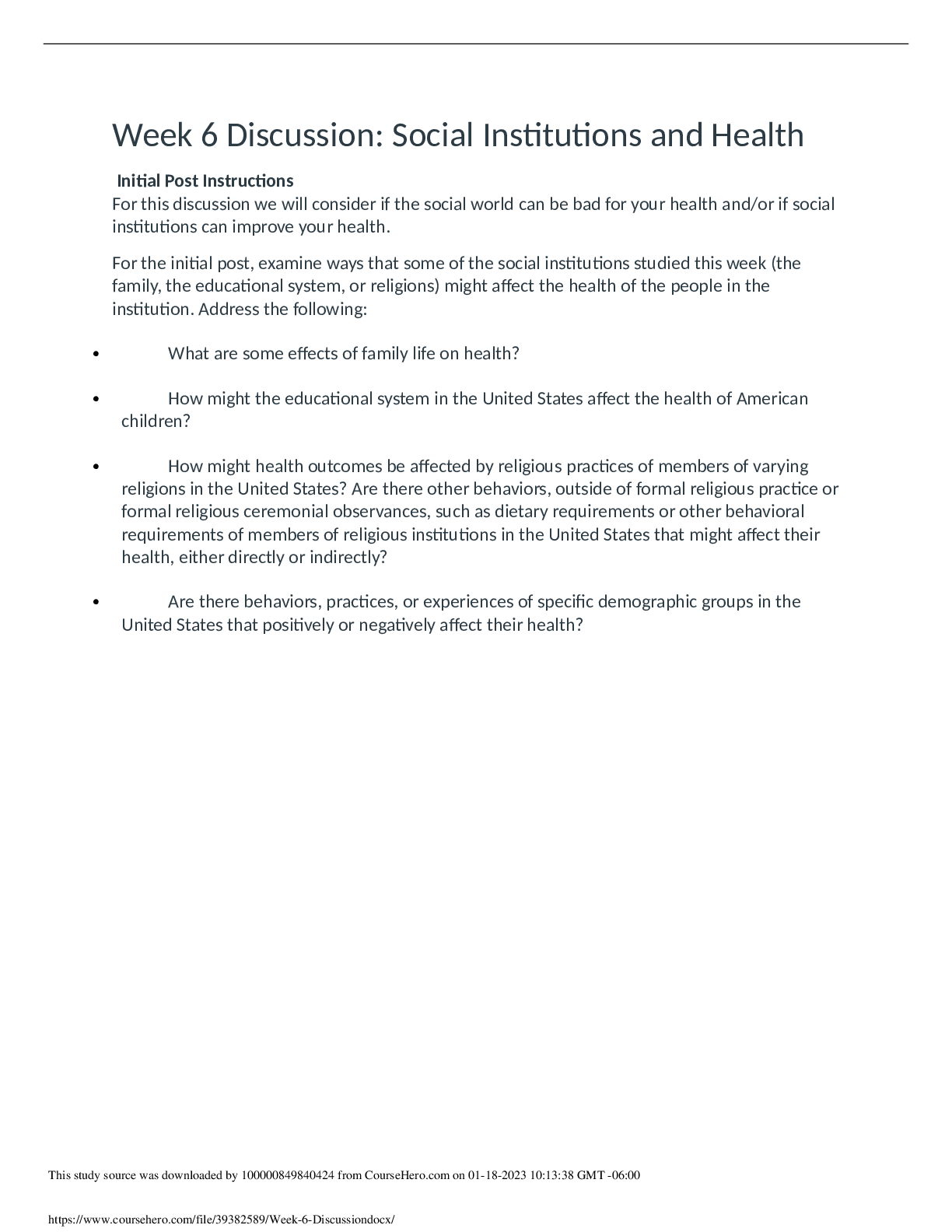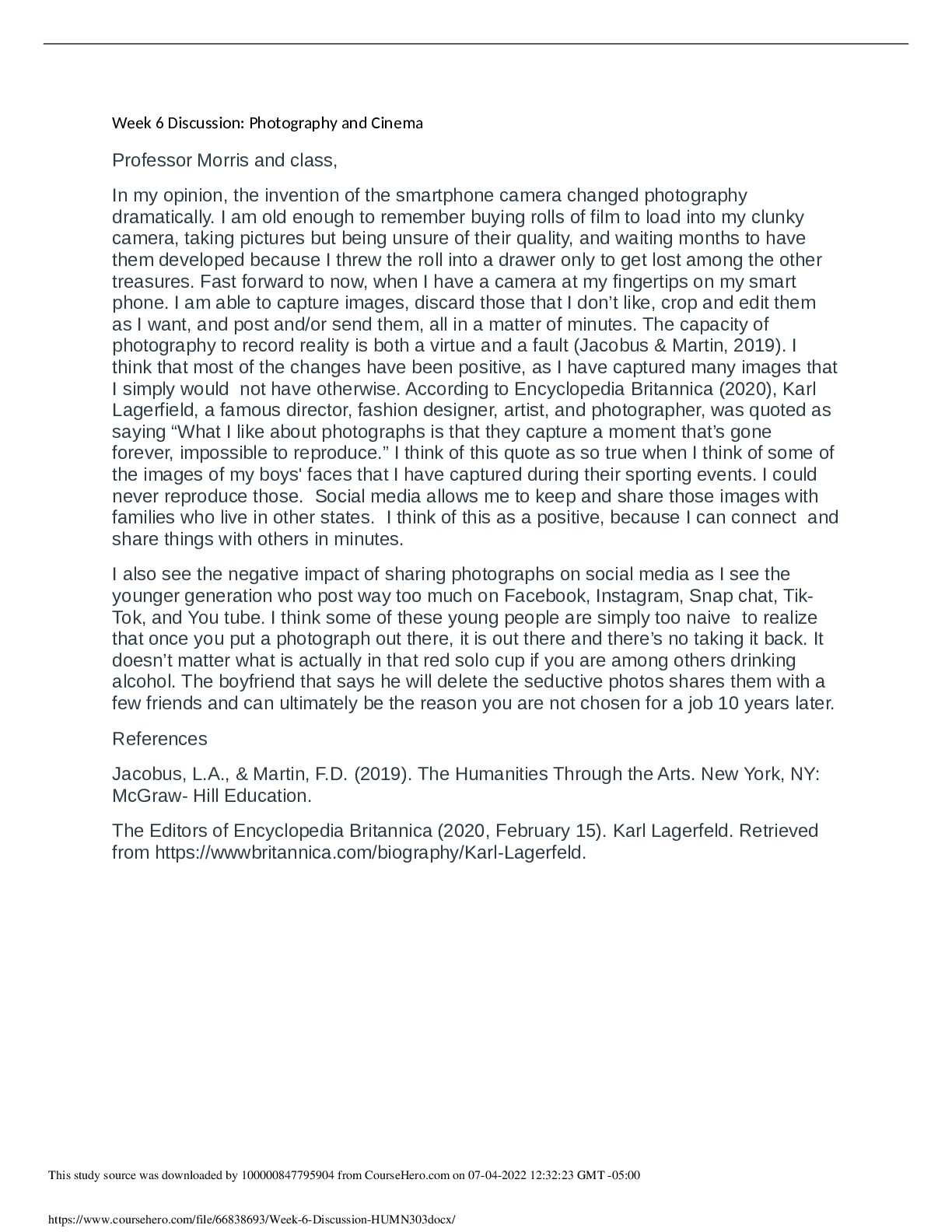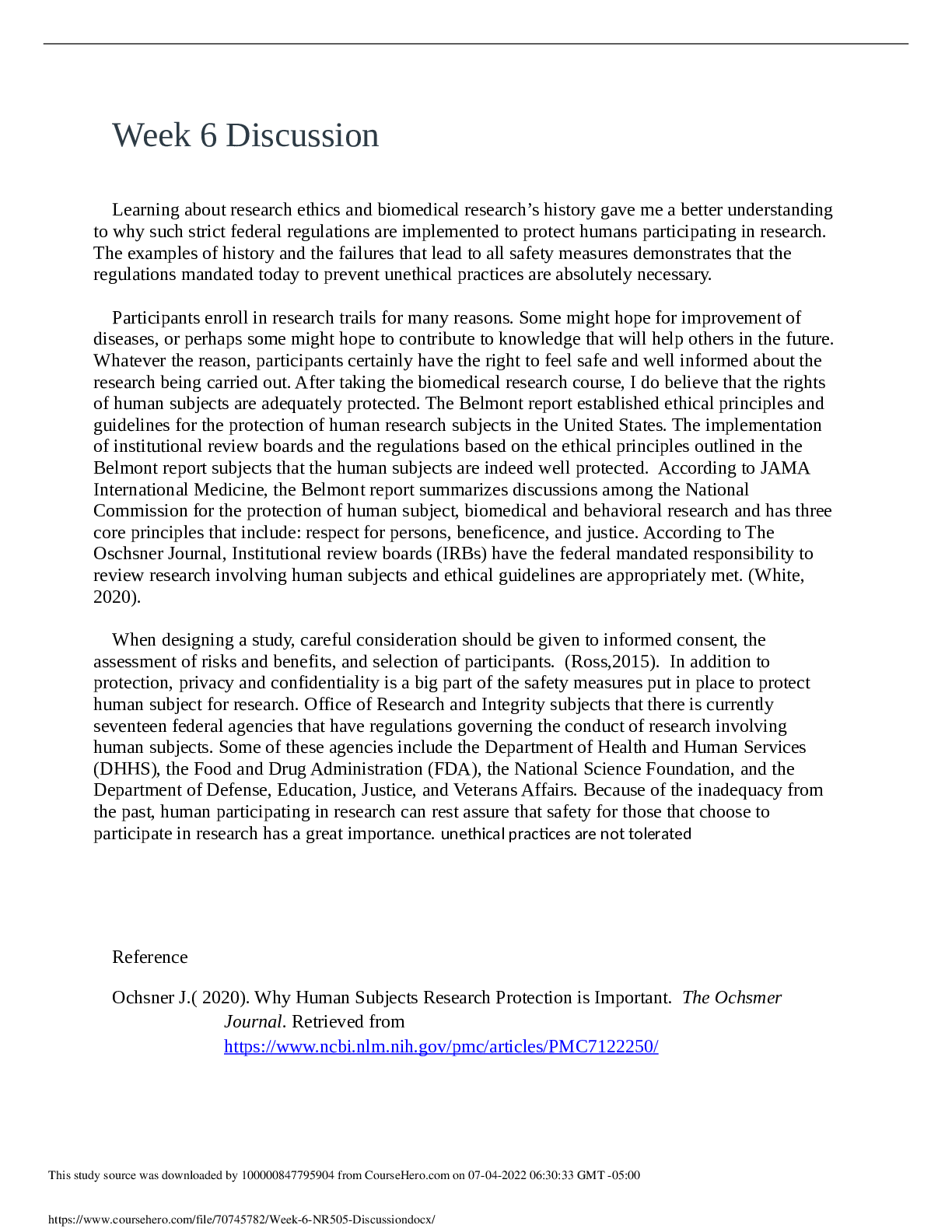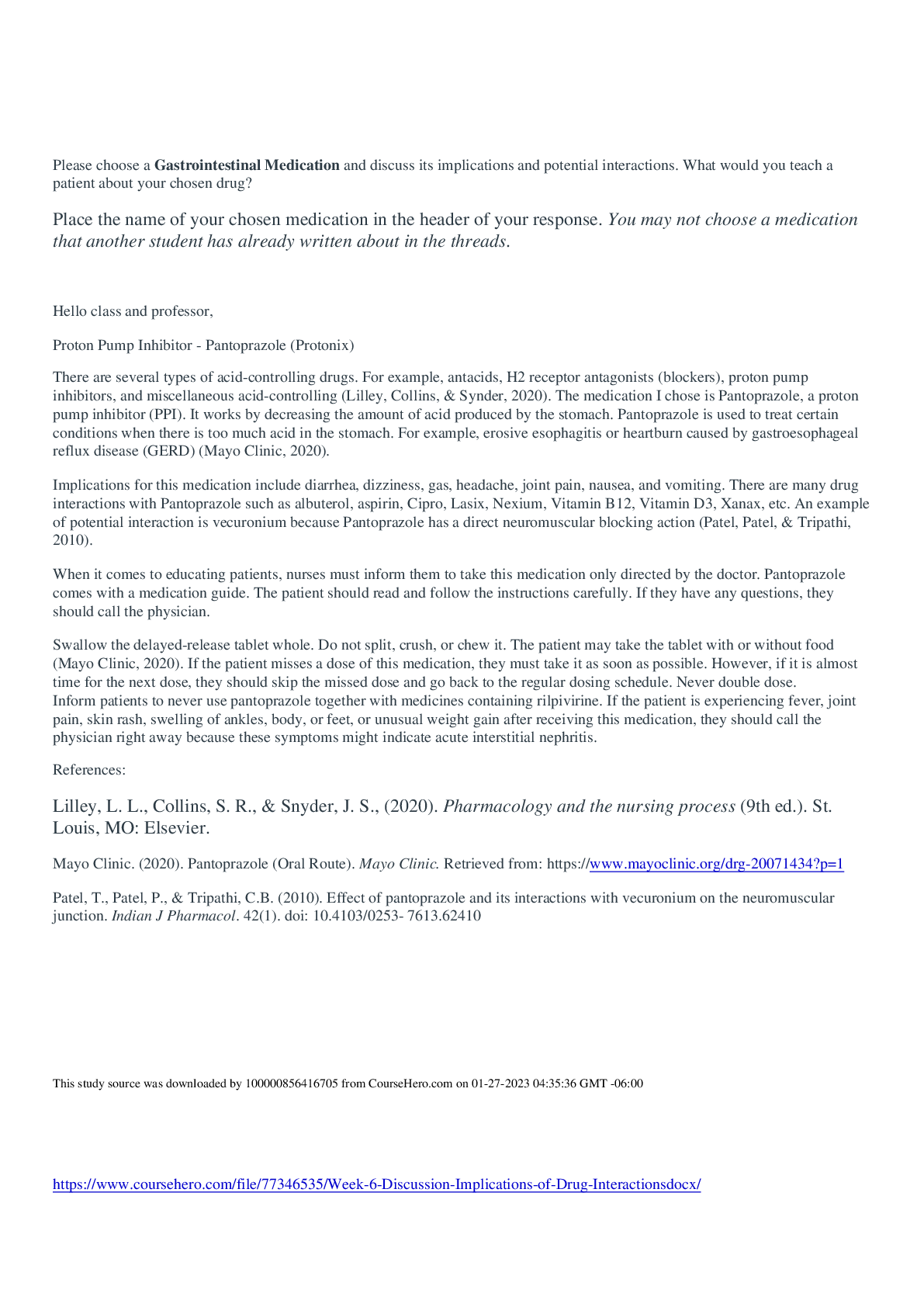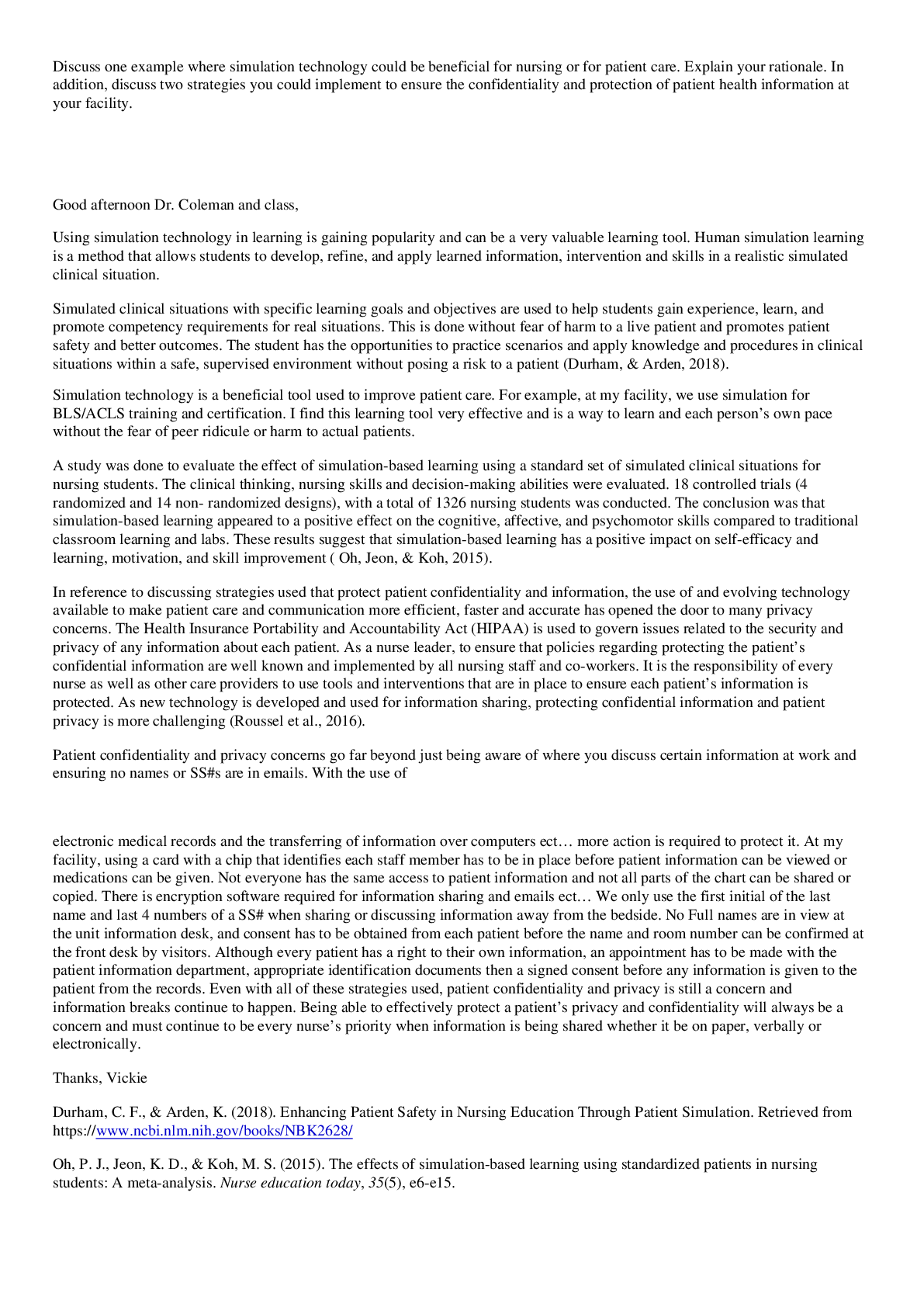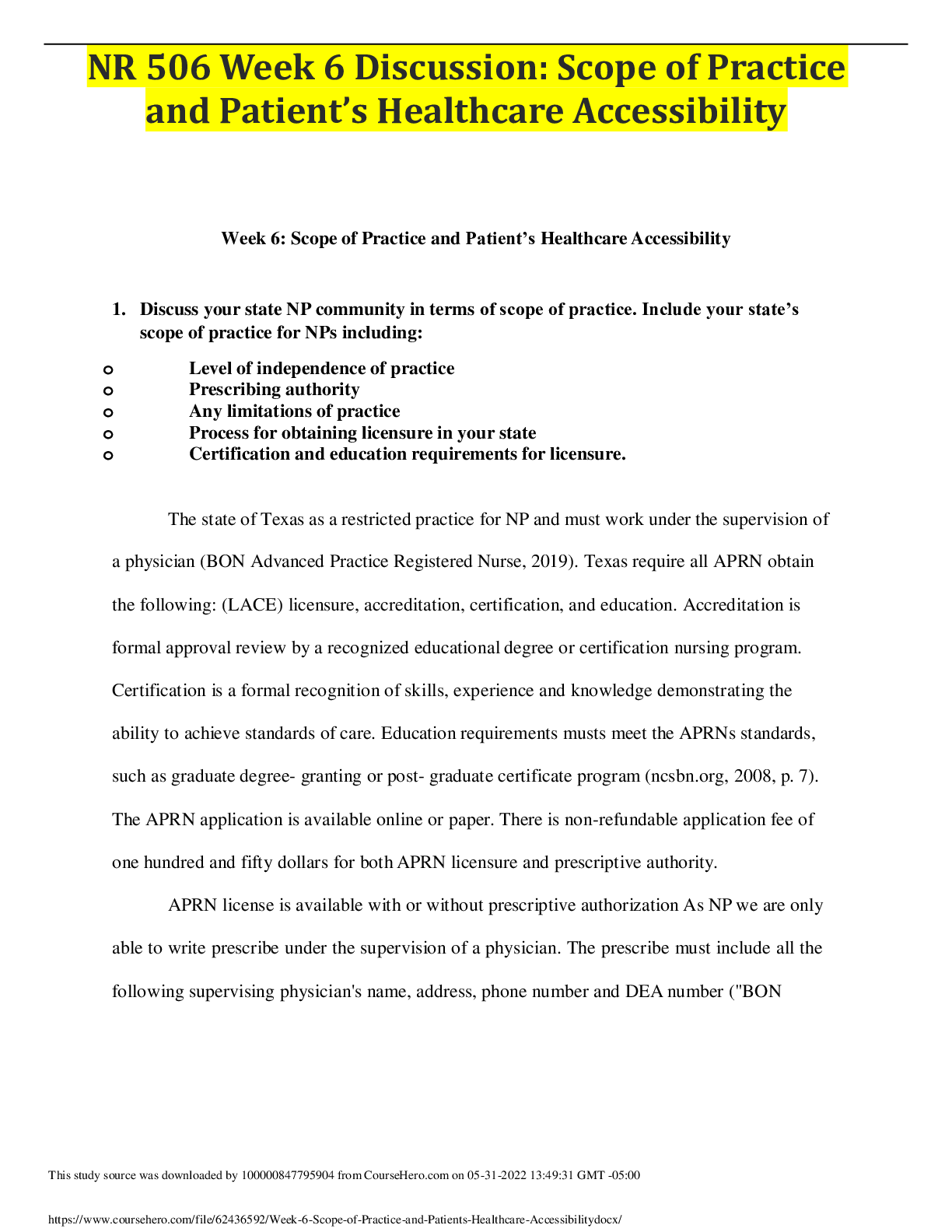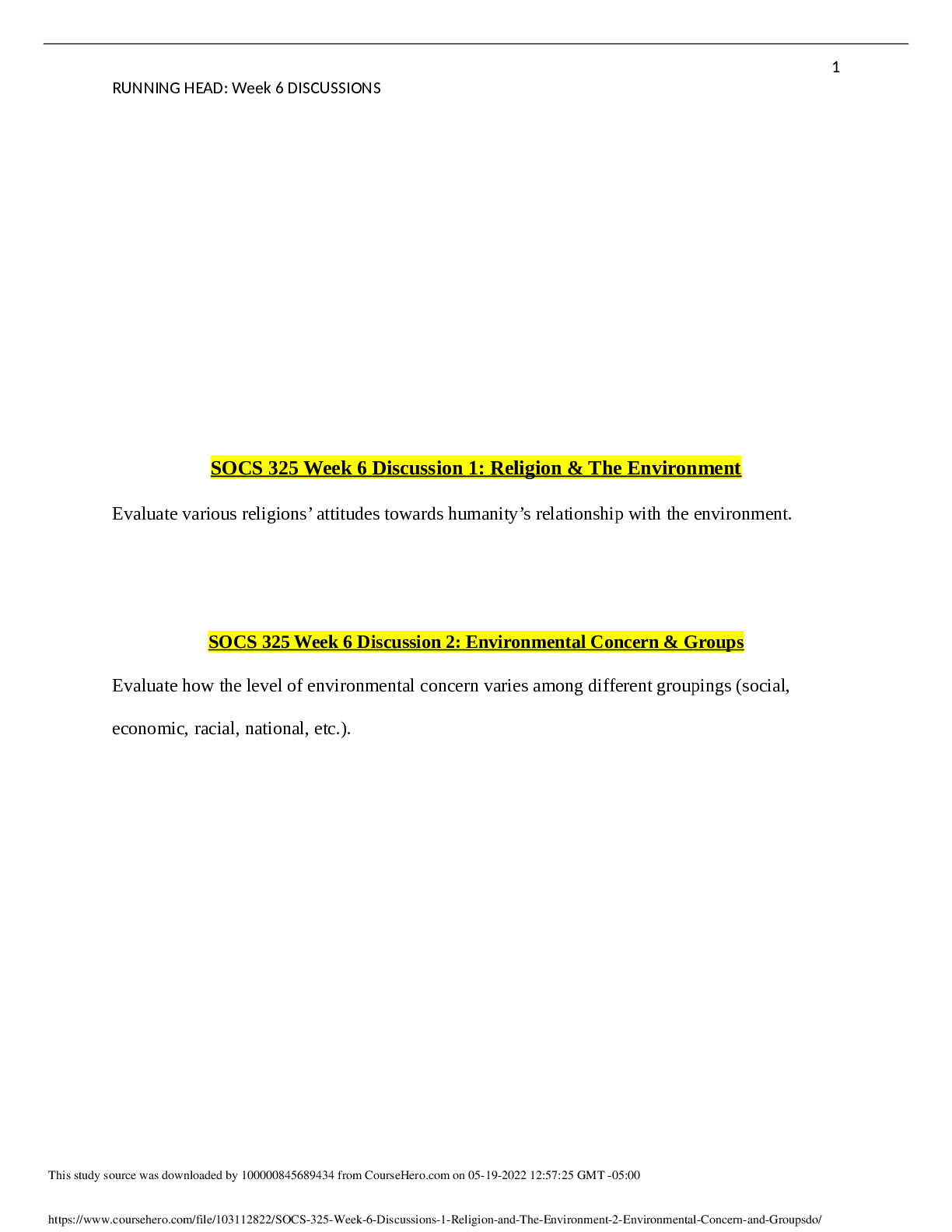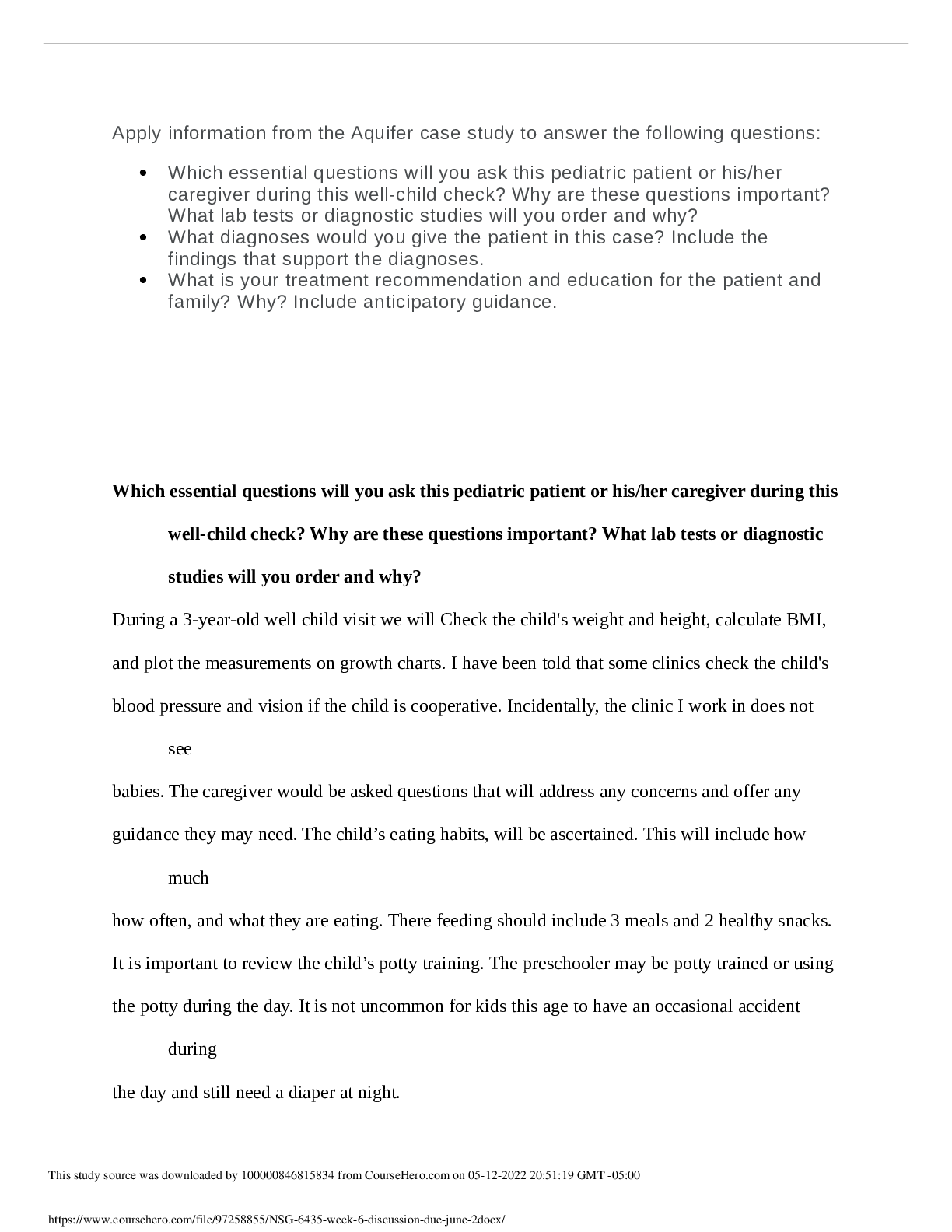Philosophy > DISCUSSION POST > PHIL 347 Week 6 Discussion 1: Comparative Reasoning- Download Paper To Get A Pass (All)
PHIL 347 Week 6 Discussion 1: Comparative Reasoning- Download Paper To Get A Pass
Document Content and Description Below
Required Resources Read/review the following resources for this activity: • Textbook: Chapter 12 • Lesson 1, 2 • Link (library article): The Doctors' Choice is America's Choice": The Physi... cian in US Cigarette Advertisements, 1930-1953 (Links to an external site.) • Link (article): The Opioid Epidemic: It's Time to Place Blame Where It Belongs (Links to an external site.) • Minimum of 1 scholarly source (in addition to the textbook and noted readings) Introduction The medical profession has a muddled and contradictory association with its approach toward the tobacco industry. While the profession now firmly opposes to smoking and vigorously publicizes the serious, even fatal, health hazards associated with smoking, this was not always so. Advertisements for tobacco products, including cigarettes "... became a ready source of income for numerous medical organizations and journals, including the New England Journal of Medicine and the Journal of the American Medical Association (JAMA), as well as many branches and bulletins of local medical associations" (Wolinsky & Brune, 1994). Physicians and reference to doctors and smoking were once common in tobacco industry advertisements. The story of physicians and promotion of smoking can be found in "The Doctors' Choice Is America's Choice" (Gardner & Brandt, 2006). The role of physicians in the current opioid crisis is now under scrutiny on television (Farmer, 2019) by trade publications (King, 2018), peer-reviewed journals (deShazo, et al, 2018), and by physicians themselves (Hirsch, 2019). Initial Post Instructions For the initial post, research the history of the association of doctors with tobacco companies and tobacco advertising. Read about the association of doctors with the opioid crisis. Then, address the following: • In what way are the two situations comparable? • In what way are they different? • Apply the concept of moral equivalence. Is the conduct of doctors in relation to smoking and the tobacco industry morally equivalent to the conduct of doctors in the opioid crisis? Explain your position and be very specific. Follow-Up Post Instructions Respond to at least one peer. Further the dialogue by providing more information and clarification. Writing Requirements • Minimum of 2 posts (1 initial & 1 follow-up) • Minimum of 2 sources cited (assigned readings/online lessons and an outside source) • APA format for in-text citations and list of references Grading This activity will be graded using the Discussion Grading Rubric. Please review the following link: • Link (webpage): Discussion Guidelines Course Outcomes (CO): 3, 4, 5, 6 Due Date for Initial Post: By 11:59 p.m. MT Recommended by Wednesday Due Date for Follow-Up Posts: By 11:59 p.m. MT on Sunday Posts must be on separate days. Search entries or author Filter replies by unreadUnread Collapse replies Expand replies Subscribed Jason Oakes Jason Oakes Apr 21, 2021Local: Apr 21 at 12:41am<br>Course: Apr 20 at 10:41pm Manage Discussion Entry Hey Gang, This is a week where it is easy to have an unfair opinion of those in the past. When we see ads like below, we will have a negative view of those involved, as if they were attempting to harm those who were influence by the ads. This week, try hard to engage in both issues (smoking in the past and opioids in the present) using all your critical thinking skills and a charity toward humans from both the past and the present. Christina L. Rainey et al., Chemical Characterization of Dissolvable Tobacco Products Promoted To Reduce Harm, 59 J. AGRIC. AND FOOD CHEMISTRY 2745 (2011). Collapse SubdiscussionNatasha Yeboah Natasha Yeboah Jun 7, 2021Local: Jun 7 at 2:06am<br>Course: Jun 7 at 12:06am Manage Discussion Entry hello Professor, "Comparative reasoning enables us to make interpretations, draw inferences, or offer explanations by relying on something that is more familiar to understand something that is less familiar" (Facione & Gittens, 2016). The two situations are comparable because doctors were used to aid in the increase in sales of these products. In 1964, Camels had a slogan that stated, "More doctors smoke Camels than any other cigarette" (Gardner & Brandt, 2006). This obviously influenced a tremendous increase in their sales because it is only fair to assume that because doctors (the individuals who are to promote health and treat illness) smoke cigarettes, it should safe for other people to smoke as well. In regards to opioids, pain is something that many suffer from in their everyday lives. In the early 1990's “medical experts” and “thought leaders” led by the neurologist and pain specialist Russell Portenoy, MD, proclaimed that the risks of addiction to opioids were minimal and that not treating pain was cruel and even amounted to medical negligence" (Gale, 2016). Therefore, doctors would simply write a script for a patient that was experiencing any pain and failing to do so would make them a poor doctor because they would not be treating their patients accordingly. As opioids were being prescribed in larger quantities ,it was not long after that notable abuse was acknowledged. These two situations are different because, as previously mentioned in regards to opioids, physicians were truly prescribing these medications for the management of their patients' pain and promote comfort (Hirsch, 2017). This was not an intentional act to cause addiction among people. Doctors that were promoting cigarette companies were doing so for their own benefit by being sponsored and receiving products for their own use. I do not think these situations have moral equivalence because the doctors that were promoting tobacco use were doing so because they were benefitting from it as they were advertising. Whereas, the doctors that were prescribing opioids were doing so with the intentions of their patients benefitting from it. Reference: Facione, P.A., & Gittens, C.A. (2016). Think critically (3rd ed.) Boston: Pearson Gale, A. (2016, August). Drug Company Compensated Physicians Role in Causing America's Deadly Opioid Epidemic: When Will We Learn? Retrieved o Destinie Garrity Destinie Garrity Jun 11, 2021Local: Jun 11 at 9:19am<br>Course: Jun 11 at 7:19am Manage Discussion Entry Hello Natasha, Great post! I strongly agree with your last statements about how the prescribing of opioids by doctors was not an intentional act to cause addiction among people. I truly believe when opioids were prescribe majority of the reasoning was done with good intentions to help people in pain. An article I found explains that good intentions contributed to bad outcomes in regards to the opioid crisis (Rummans et al., 2018). A fact worth sharing from this research article on the opioid crisis is that the United States leads the world in opioid use, consuming roughly 80% of all the world’s opioids (Rummans et al., 2018). The reason I shared this quote is because I think it puts in perspective just how much the United States has been affected by this crisis. Cigarette consumption is found significant globally but the fact that opioids are being consumed at a total of 80% worldwide is crazy to me. Thank you for sharing! -Destinie References Rummans, T. A., Burton, M. C., & Dawson, N. L. (2018). How Good Intentions Contributed to Bad Outcomes: The Opioid Crisis. Mayo Clinic Proceedings, 93(3), 344–350. https://doi.org/10.1016/j.mayocp.2017.12.020 o Collapse SubdiscussionOluwasegun Olorunwa Oluwasegun Olorunwa Jun 11, 2021Local: Jun 11 at 5:46pm<br>Course: Jun 11 at 3:46pm Manage Discussion Entry Hi Natasha, You did a great Job. I will start from your words ''The two situations are comparable because doctors were used to aid in the increase in sales of these products''. Doctors are in the center of both situations to generate and increase sales. They are placed in situation with no option than to support, promote and boosts sales. I also support the fact that the doctors were prescribing opioids basically in the interest of the patients. The have no negative intention to cause addiction where as, promotion of cigarette was for their own benefit ▪ Jason Oakes Jason Oakes Jun 11, 2021Local: Jun 11 at 9:26pm<br>Course: Jun 11 at 7:26pm Manage Discussion Entry This is a great discussion, keep it up gang. o Geralyn Leone Geralyn Leone Jun 13, 2021Local: Jun 13 at 10:34pm<br>Course: Jun 13 at 8:34pm Manage Discussion Entry Hi Natasha, How crazy is it to this that in 1964 Camel cigarette company used doctors to sell their product? In 1950 British researchers demonstrated a clear relationship between smoking and cancer. By 1970, the US Surgeon General determined that smoking posed health risks to smokers, and the banned women from smoking while pregnant. Collapse SubdiscussionDestinie Garrity Destinie Garrity Jun 7, 2021Local: Jun 7 at 2:22pm<br>Course: Jun 7 at 12:22pm Manage Discussion Entry Hello Professor and Class, These two situations are both similar in the fact that they are two major crises in the United States. Hirsch (2017) explains the role of these physicians in the opioid crisis can best be described as innocent bystander, but that there were also what are known as “pill mill” doctors who accepted cash payments to prescribe opioids to anyone willing to purchase them. Similarly, the tobacco companies and doctors being sponsored by certain tobacco companies were agreeing to advertisements to support the use of tobacco to the public. Gardner & Brandt (2006) explains that the tobacco company “Camel” used a marketing strategy of giving free cartons of cigarettes to doctors in support of their advertisements falsely reassuring the public of the health effects to smoking. These two situations are different because the opioid crisis started out with good intentions; meanwhile the tobacco industry never had people’s best interest in mind. An article I found explains that good intentions contributed to bad outcomes in regards to the opioid crisis (Rummans et al., 2018). A fact worth sharing from this research article on the opioid crisis is that the United States leads the world in opioid use, consuming roughly 80% of all the world’s opioids (Rummans et al., 2018). Our assigned article explained that in 1998, the United States signed the Tobacco Master Settlement Agreement between the four largest tobacco companies and the attorney generals of 46 states to limit advertisement and provide payments to cover cost of tobacco-related illnesses (Hirsch, 2017). I believe like this article states that there has to be a parallel Opioid Master Settlement Agreement to pay for treatment and prevention efforts for all affected by the opioid crisis (Hirsch, 2017). I do believe that the doctors in relation to tobacco industry and opioid crisis are morally equivalent. Although I absolutely feel this is debatable because there are indeed many physicians out there that were caught selling opioids for extra cash, just as we read that there were physicians taking free cigarettes in return of supporting a company that sells products harmful to people. My reason for stating they are both morally equivalent is because after reading both articles it is clear to see that in both situations physicians were caught in the wrong. Now I understand the initial intentions of opioids was to help patients with their pain, but there was significant over prescribing done that caused many people to become addicted. The same for tobacco companies and the doctors supporting cigarettes causing people to become addicted to something that causes harmful respiratory illnesses. References Facione, P.A., & Gittens, C.A. (2016). Think critically (3rd ed.) Boston: Pearson Gardner, M. N., & Brandt, A. M. (2006). “The Doctors’ Choice Is America’s Choice”. American Journal of Public Health, 96(2), 222–232. https://doi.org/10.2105/ajph.2005.066654 Hirsch, R. (2017). The opioid epidemic: It’s time to place blame where it belongs. Missouri Medicine. Retrieved from https://www.ncbi.nlm.nih.gov/pmc/articles/PMC6140023/ Rummans, T. A., Burton, M. C., & Dawson, N. L. (2018). How Good Intentions Contributed to Bad Outcomes: The Opioid Crisis. Mayo Clinic Proceedings, 93(3), 344–350. https://doi.org/10.1016/j.mayocp.2017.12.020 o Jason Oakes Jason Oakes Jun 9, 2021Local: Jun 9 at 9:59pm<br>Course: Jun 9 at 7:59pm Manage Discussion Entry Thanks for getting an early start in this discussion. (1 like) o Collapse SubdiscussionMeryl McGowan Meryl McGowan Jun 10, 2021Local: Jun 10 at 12:44pm<br>Course: Jun 10 at 10:44am Manage Discussion Entry Hey Destinie, Your post was very clear on your opinions and easy to comprehend. I agree with you that the two issues are relatable and morally equivalent but also different in some of the providers intentions. The study talked about patient satisfaction surveys and how the providers would never be given high marks if their patients weren't happy... so they attempted to make them happy but by giving in to the demands of pain medication, fueled the cycle instead of stopping it. Now, we have so many rules and regulations attached to opioids and narcotics. Before prescribing them to a patient, the provider is able to look up the patient on the state data base to see if they have had anything filled recently, by way of controlled substances. If they had, they could print out the report, take it to the patient and have an open and honest conversation about why and when. Once the patient attempted to explain the use and how often they used the mediation, the provider can then make an informed decision on if they felt the medication was necessary. Maybe the patient is ready for help or treatment of some addiction issue, the provider would need to be ready to help in anyway they can and stop the judgement of what happens alot today. Also, in NC, starting this January, laws are now in place to where pharmacist and providers are working hand in hand to try and stop the supply on the streets. This happened with a new law enacted to where only 5 days of medication can be written and dispensed at a time for new onset pain and 7 days for post surgery patients. Time will tell if this law helps but early signs are that it has and these drugs are getting harder and harder to find on the streets or left over in patient's homes. Meryl Resources & Information. New! Summary of NC's new opioids law, the STOP Act. (n.d.). https://www.ncmedboard.org/resources- information/professional-resources/publications/forum- newsletter/notice/new-summary-of-ncs-new-opioids-law-the-stop-act. (1 like) ▪ Destinie Garrity Destinie Garrity Jun 11, 2021Local: Jun 11 at 8:56am<br>Course: Jun 11 at 6:56am Manage Discussion Entry Meryl, Thank you for your reply! Wow that is amazing to here about the new law passed in NC, and I am also curious to see how that works but glad they are initiating this. I think it is a great law and hope it truly helps people find the courage to get help or at least admit that they are addicted. It is great that doctors will be working hand in hand with pharmacists to visual the usage of opioids because I feel that these issues stemmed from the unknown of whether patients were just prescribed opioids or not. -Destinie o Fenisha Vice Fenisha Vice Jun 11, 2021Local: Jun 11 at 1:14pm<br>Course: Jun 11 at 11:14am Manage Discussion Entry Hey, Destinie! I agree that the opioid crisis was not intended to cause harm, but that it was originally meant for good. I also agree that meanwhile the tobacco companies never intended any good by selling their products. Yes! In both scenarios, the doctors should be held to a certain level of accountability. While it was not intended to cause an opioid crisis, the doctors must be care not to over prescribe those medications, because of the horrible affects and possible addiction to the medications. I enjoyed reading this post! (1 like) o Dhruvi Patel Dhruvi Patel Jun 13, 2021Local: Jun 13 at 5:57pm<br>Course: Jun 13 at 3:57pm Manage Discussion Entry Hello Destinie, Thank you for your post for this week, I enjoyed reading it and we have similar opinions on the two situations. However, you said that physicians in both situation are morally equivalent because they were caught doing wrong. For example, physicians working with tobacco companies were jeopardizing their patient’s health and physicians involved in opioid crises were over prescribing their patient that cause them to become addicted. I agree with your reason, but I do not think that both situations were morally equivalent because physicians who were engaged with tobacco companies knew that smoking was harming their patient but they themselves became addicted to smoking because it was popular at the time and moreover they were still prescribing a better brand of cigarettes to their patients even after their patient were getting harsh symptoms. On the other hand, physicians with opioid crises did overprescribe their patient to relieve their pain and in return their patient got addicted but it all happened unintentionally. o Kierra Woods Kierra Woods Jun 13, 2021Local: Jun 13 at 7:06pm<br>Course: Jun 13 at 5:06pm Manage Discussion Entry This is a great post Destinie and I agree with your comparison. I too feel the opioid crisis started out with good intentions as opposed to cigarette companies not caring about the well being or their customers but rather trying to make a buck. I'm sure the opioid manufacturers wanted to make money as well however the entire purpose of pharmaceuticals is to help people where the cigarette can not and has never been able to say the same. o Ziare Davis Ziare Davis Jun 13, 2021Local: Jun 13 at 8:38pm<br>Course: Jun 13 at 6:38pm Manage Discussion Entry Destinie what's up Reading your respond I can tell you came with a big bang you seem very informative and very knowledgable, Opioids wasn't meant to destroy/ kill lives. Selling them isn't the right thing to do, they should enforce things like that professional and enforce it in hospitals. Also I agree with you on tobacco companies and the doctors supporting cigarettes causing people to become addicted to something that causes harmful respiratory illnesses. Why promote something that is harmful to humans ? aren't doctors suppose to teach health and wellness. Collapse SubdiscussionBousso Diop Bousso Diop Jun 7, 2021Local: Jun 7 at 8:17pm<br>Course: Jun 7 at 6:17pm Manage Discussion Entry Hello class, only two more weeks and hopefully we will all jump the next level! In what way are the two situations comparable? The conduct of doctors in relation to smoking and the tobacco industry is not morally equivalent to the conduct of doctors in the opioid crisis. Moral equivalence is if the claim is either “As good as or as bad as” (Chamberlain, 2020). The involvement of doctors to the false advertisement of smoking stopped when they learned about the risks of cigarette smoking in our health (Gardner, M. N., & Brandt, A. M., 2006). On the other hand, in opioid crisis, the doctors are still involved by prescribing narcotics to their patients despite knowing the risks, of narcotic in our health. By that, one cannot say that up to now, 2020, doctors are still responsible for the smoking-related lung cancer unlike how one can easily blame opioid crisis to doctors because they are still prescribing them. The level of responsibility and circumstances are significantly different and cannot be ignored; thus, making the comparison faulty and is therefore a false moral equivalence. References Gardner, M. N., & Brandt, A. M. (2006). The doctors' choice is America's choice: the physician in U.S. cigarette advertisements, 1930-1953. American Journal of Public Health, 96(2), 222–232. doi:10.2105/AJPH.2005.066654 Chamberlain (2020). Week 6 lesson 2: moral equivalence. Chamberlain University. Retrieved from: https://chamberlain.instructure.com/ courses/59326/pages/week-6-lesson-2-moral-equivalence? module_item_id=7686702 o Natasha Yeboah Natasha Yeboah Jun 10, 2021Local: Jun 10 at 12:25am<br>Course: Jun 9 at 10:25pm Manage Discussion Entry Hi Boussou, I totally agree with your post. they are comparable with their false advertisement, because they know it is not right for people but they still advertise and always get good companies to support. Tobacco companies and doctors being sponsored by certain tobacco companies were agreeing to advertisements to support the use of tobacco to the public. (1 like) o Nordia Maddis Nordia Maddis Jun 11, 2021Local: Jun 11 at 7:15am<br>Course: Jun 11 at 5:15am Manage Discussion Entry Hello Bousso, I agree with you that physicians were involved in the two situations to increase the sale of opioids and cigarettes. According to (Gardner & Brandt 2006) the slogan for Camels was "more doctors smoke Camels than any other cigarette”.The slogan increased their sales as people viewed it as right smoke as doctors also smoked. In the opioid case doctors also benefited. According to ( Gale 2016), “Dr. Portenoy and his pain center have received millions of dollars of funding from many pharmaceutical companies including Purdue Pharma, the manufacturer of OxyContin, as well numerous other well-known drug manufacturers such as Mallinckrodt, Wyeth, Baxter, and Pfizer.” (1 like) o Danielle Diaz Danielle Diaz Jun 13, 2021Local: Jun 13 at 7:57pm<br>Course: Jun 13 at 5:57pm Manage Discussion Entry Hello Boussou, The fact that doctors are agreeing to be sponsored by these tobacco companies and opioid use and took part in false advertising does make them very comparable and similar. They were aware of the harmful adverse effects but still choose to advertise them. I agree with you 100%. (1 like) Collapse SubdiscussionChristina Mekhail Christina Mekhail Jun 7, 2021Local: Jun 7 at 10pm<br>Course: Jun 7 at 8pm Manage Discussion Entry Hello Professor and Classmates, 1. In what way are the two situations comparable? First and foremost, cigarettes and tobacco causes cancers (mostly in the lungs because tobacco targets that area). Tobacco companies are hired doctors for promotions of tobacco product, and claim false advertisement that their products are don't cause irritation to nose and mouth. After analyzing statistics that identify smoking causes lung cancer, doctors soon did not include themselves apart of this promotion on smoking. Doctors now encourage everybody to avoid smoking completely, and take it out of their systems before it becomes an even worse addiction. 2. In what way are they different? Both, opioid crisi and tobacco are very unhealthy to human health due to the risk of overdosage/usage. Although doctors do avoid prescribing smoking, it depends on the patients situation because smoking may act as a pain reliever o Collapse SubdiscussionJason Oakes Jason Oakes Jun 10, 2021Local: Jun 10 at 8:31pm<br>Course: Jun 10 at 6:31pm Manage Discussion Entry Thanks for this Christina Do you think that Doctors are still as widely regarded today as they were then? ▪ Shedly Jean-Noel Shedly Jean-Noel Jun 14, 2021Local: Jun 14 at 12:39am<br>Course: Jun 13 at 10:39pm Manage Discussion Entry Hello Dr. Oakes, If I may answer that question, I do believe that doctors are still widely regarded today as they were then. I can take an example, many elderly people do not believe in certain things that a close family or friend may suggest to them about their health but the moment they hear it from a doctor, they definitely trust him/her. This is not only in regards to elderly people, I have seen many other groups of people do that as well. But many can argue with my statement depends on their own experiences. o Elisa Rodriguez Elisa Rodriguez Jun 11, 2021Local: Jun 11 at 8:53pm<br>Course: Jun 11 at 6:53pm Manage Discussion Entry Hello Christina, I enjoyed reading your post. You mentioned some valid points on the correlation of both situations. I like that you pointed out the fifth vital sign, which is pain. Vital signs measure your body's basic functions. Monitoring them allows medical professionals to assess the wellbeing of the patient they are caring for. Doctors are responsible to do everything possible to satisfy the patient. Relieving a patient's pain is the doctor's ethical responsibility in which in certain scenarios opioids are the necessary option. Unfortunately, opioids are addictive drugs that can be misused. Tobacco and opioids both are addictive drugs and Even though tobacco and opioids are used differently they both are addictive, unhealthy, and an overall all health risk. Thank you for your post! o Milena Wlodkowska Milena Wlodkowska Jun 12, 2021Local: Jun 12 at 3:46pm<br>Course: Jun 12 at 1:46pm Manage Discussion Entry Hello Christina, The concern of adverse health effects cigarettes and tobacco causes on individual has been brought out. The involvement of doctors by tobacco companies to endorse consumption of such drugs has given rise to increase in number consumers of tobacco substances. There is direct correlation of analysis of statistics of the harmful effects of tobacco as a leading cause of cancer. Corrective mechanism where people are encouraged to avoid smoking cigarettes and promote health life has been captured. The statement do not state clearly whether opioids or tobacco is prescribed by the doctor. Risk healthy factors involved in consuming both are high but you could have note the use of opioids for medical purposes by those practicing it to suppress pain associated with certain illnesses. Your arguments are well elaborated in that the main purpose of use of opioids by doctors is to relieve pain for certain ailments in patients. Doctors promoting smoking of cigarettes are doing it for lifestyle purposes and has been proven to be detrimental to one’s health. Collapse SubdiscussionOluwasegun Olorunwa Oluwasegun Olorunwa Jun 8, 2021Local: Jun 8 at 7:04pm<br>Course: Jun 8 at 5:04pm Manage Discussion Entry In what way are the two situations comparable? The two situations are comparable. Doctor’s choice believes tobacco companies manipulate reviews and quotes from physicians to make their product seem to be the healthiest/safest. This is a strategy that encourages individuals to believe in their product and eventually become addicted which generates sales. As per the opioid crisis, doctors were left with no choice that to figure out how to receive a positive rating. This is done to improve patient’s satisfaction. They tend tpo prescribe substantial amounts of pain prescriptions which in turn leads to opioid addiction. In what ways are they different? The two situations are different because in the cigarette addiction doctors knew what was going on and can probably curtail it. In the opioid crisis, they were handicapped because they have no choice that to protect their reputation. A negative rating which could harm their practice and impair their career. They had to settle for giving out pain medications to patients to ensure they never felt uncomfortable and guarantee a healthy rating. Apply the concept of moral equivalence. Is the conduct of doctors in relation to smoking and the tobacco industry morally equivalent to the conduct of doctors in the opioid crisis? Explain your position and be very specific. I do not believe the two concepts are morally equivalent. My response is heavily dependent on the circumstances of the two situations. These are two different situations. In the opioid concept, the doctors were subjected to do everything possible to satisfy the patients. When the evidence of addiction came out, they quickly moved to initiate a change. Doctors consider the ethical responsibility to push for a solution rather than ignoring the issue on hand. In the smoking concept, doctors were aware about the manipulations of the tobacco company, yet they ignore and pay no attention to it despite relevant evidence was provided of its detrimental effects. It took them decades to even begin to address the manipulation of evidence or lies big tobacco companies were spreading. o Kula Kallon-Genfi Kula Kallon-Genfi Jun 13, 2021Local: Jun 13 at 9:56pm<br>Course: Jun 13 at 7:56pm Manage Discussion Entry Hello Oluwasegun, This topic could possibly open a whole can of worms. Working in the medical field has opened my eye to a lot of loopholes in the way most of these opioid medications are prescribed. Patient medication reconciliation will shed light on how unnecessary some of these medications are to these patients. We also have to consider patients who hop from one provider to the other in search of opioid medication. The overall issue is with the providers that will prescribe the medications knowing that the patients do not need to be placed on the medications. Some are only doing it to get kickbacks from the pharmaceutical companies pushing these medications. The initial intention was good, however, some providers see dollar signs when prescribing the medications. o Christina Mekhail Christina Mekhail Jun 13, 2021Local: Jun 13 at 10:08pm<br>Course: Jun 13 at 8:08pm Manage Discussion Entry Hello Oluwasegun, First and foremost, I think that your discussion is very detailed and highlighted main parts of the questions! Excellent work! Secondly, I completely agree that cigarettes and smoking in general is held to a high addiction due to the amount of times people smoke a day. Smoking everyday can harm the lungs, and doctors and medical staff needs to make sure that they are not harming anybody. All in all, there are many different medications that patients can utilize other than smoking and having a risk of being addicted. o Bousso Diop Bousso Diop Jun 13, 2021Local: Jun 13 at 10:53pm<br>Course: Jun 13 at 8:53pm Manage Discussion Entry Hello Oluwasegun, thank you for your post, I like the way you put both situation before making a judgment. Me working on a thoracic unit and witnessed how use of tobacco can destroy people lungs, I often ask why doctors seem to ignore this danger. On the other hands they still prescribing narcotics regardless of the damage it might create. Alternative should be strongly encourage to reduce or eliminate the abuse of these substances. Collapse SubdiscussionDanielle Diaz Danielle Diaz Jun 9, 2021Local: Jun 9 at 1:08am<br>Course: Jun 8 at 11:08pm Manage Discussion Entry Hello Everyone, o Cynthia Onuoha Cynthia Onuoha Jun 13, 2021Local: Jun 13 at 7:31pm<br>Course: Jun 13 at 5:31pm Manage Discussion Entry Hi Danielle I totally agree with you. The patients and those that smoked believed that since the physicians are smoking, then it’s nothing wrong with smoking not knowing that it was only a system to increase their sales. I love how detailed your writing is. Good job Collapse SubdiscussionDaniela Mendoza Daniela Mendoza Jun 9, 2021Local: Jun 9 at 2:17am<br>Course: Jun 9 at 12:17am Manage Discussion Entry Hello class and professor! Doctors have always been viewed as the experts on health and that is why may companies like to claim that their products are "doctor approved." Knowing that doctors approve of something makes people feel more comfortable about buying a product. This has always been a great strategy. In what way are the two situations comparable? The use of tobacco and opioids have always been a huge crisis in the United States. I believe that these two are comparable because doctors have been used to promote these products. The tobacco companies and Oxycontin companies both tried to make the people believe that their products were safe to the public. We can see this when tobacco companies kept using doctors in their slogan making claims that doctors approved one more over the other. We can also see how companies tried to make the people believe that opioids were necessary when treating pain by incorporating pain as a new vital sign and by including pain management in hospital/doctor surveys. In what way are they different? Big corporations and health administrations were basically forcing doctors to prescribe these medications by creating patient surveys in which they included patient satisfaction about pain management. These surveys forced doctors to give their patients whatever they wanted so that they would not write a bad review. Doctors were basically being forced to prescribe these medications. The tobacco companies knew that their products were not safe, but they still tried to hide that by using doctor approved slogans. These tobacco companies tried to buy doctors' approval by giving them free products. Is the conduct of doctors in relation to smoking and the tobacco industry morally equivalent to the conduct of doctors in the opioid crisis? I do not think that these two are morally equivalent because in the opioid crisis, doctors were trying to help their patients and in the tobacco crisis doctors were just being used as advertising. Once new research found tobacco to be very harmful to the human body, doctors quickly became completely against cigarettes. Now cigarettes are required to say that they are harmful and can cause cancer. On the other hand, doctors have been participating in the opioid crisis by prescribing pain medication to patients that they believe are in pain. Most of these doctors were not trying to harm the patient or make them addicted to these prescriptions. They were doing it to help the patient, but then they were basically being forced to prescribe these medications by hospital administrations and big pharmaceuticals so that patients would give them a good rating. References: Facione, P.A., & Gittens, C.A. (2016). Think critically (3rd ed.) Boston: Pearson Gardner, M. N., & Brandt, A. M. (2006). “The Doctors’ Choice Is America’s Choice”. American Journal of Public Health, 96(2), 222–232. https://doi.org/10.2105/ajph.2005.066654 Hirsch, R. (2017). The opioid epidemic: It’s time to place blame where it belongs. Missouri Medicine. Retrieved from https://www.ncbi.nlm.nih.gov/pmc/articles/PMC6140023/ National Institute on Drug Abuse. (2021, March 11). Opioid Overdose Crisis. National Institute on Drug Abuse. https://www.drugabuse.gov/drug- topics/opioids/opioid-overdose-crisis. o Collapse SubdiscussionJason Oakes Jason Oakes Jun 10, 2021Local: Jun 10 at 8:32pm<br>Course: Jun 10 at 6:32pm Manage Discussion Entry Thanks Daniela Do you think that doctors are relied upon as dependable people in most or even all areas of life. Should we view them this way? Aren't they, if nothing else, to be relied upon in situations such as these... health? ▪ India Whitfield India Whitfield Jun 13, 2021Local: Jun 13 at 12:28pm<br>Course: Jun 13 at 10:28am Manage Discussion Entry Hello Professor, Yes I do think that doctors are relied on as dependable people, especially regarding the health and care of someone. This should not be the case, as I watched a documentary that has me questioning if these doctors should be the only person people rely on for their medical attention. The documentary I watch yesterday called " The Bleeding Edge", talks about the downfalls that happen to patients after they trust and listen to their doctors on which new medical devices to put into their body. For example, in the documentary, there was a new medical device called Essure from a well know company known as Bayer, that was made as a permanent birth control. Essure entered the market around 2002, and doctors were the first point of care to introduce patients to this new birth control device but soon after thousands of women were reporting horrible medial problems from this small device. The device would move from the fallopian tubes into the uterus causing major bleeds, fragments would break off inside the body, doctors would implant 6 or more into the uterus if didn’t go into the fallopian tubes when only 2 was recommended, pregnancy would still happen but with horrible effects to the baby and a lot more. Still doctors were recommended this type of birth control to women without disclosing the risk of this medical device for years. The medical device was so unsafe that it was taken off the market around the world in 2017 and in the US in 2019. This documentary has taught me to never take the word from the doctor regarding your health and what to put inside your body. Also to always get a second, third or even fourth opinion and to conduct your own research before just agreeing to what any doctor recommends to do with your body and health. Collapse SubdiscussionMavis Appiah Mavis Appiah Jun 9, 2021Local: Jun 9 at 11:23am<br>Course: Jun 9 at 9:23am Manage Discussion Entry In what way are the two situations comparable? Our text explains comparative reasoning as a this-is-like-that thinking which enables us to make interpretations by relying on something that is more familiar to understand something that is less familiar (Facione & Gittens, 2016). Cigarette smoking may be a predictor of the risk of opioid misuse and tobacco crisis and opioid crisis appear to be mutually reinforcing. People who smoke also have a higher likelihood of opioid misuse. In some instances, doctors have been paid hefty amounts of money to prescribe opioid medications to increase sale and earn high ratings. Both tobacco and opioid use causes public health crisis in the United States and around the world. In both situations, doctors have been utilized to increases sale. Both situations also represented false advertisement because the risk factors of using these medications were not properly laid out In what way are they different? The major difference between the two situations is that tobacco can basically be obtained around every corner. Opioid on the other hand needs a doctor’s prescription. In the instance of opioid use, doctor’s may be willing to prescribe pain medication to satisfy their patients for higher ratings and to push sales. The same cannot be said for tobacco use as doctor’s did not have a role to play in people who use tobacco and whether they are satisfied with its use or not. o Collapse SubdiscussionJason Oakes Jason Oakes Jun 10, 2021Local: Jun 10 at 8:33pm<br>Course: Jun 10 at 6:33pm Manage Discussion Entry Thanks Mavis Do you have any sympathy for a cigarette company saying that they are simply providing a product that people want? They might say that they are not responsible for how many cigarettes someone smokes, that is on the individual. Are they as a company that different than and Ice Cream chain or something else that can be dangerous to your health if overused or overeaten? ▪ Mavis Appiah Mavis Appiah Jun 12, 2021Local: Jun 12 at 1:43pm<br>Course: Jun 12 at 11:43am Manage Discussion Entry Hello Professor, Thanks for responding to my post, the fact that smoking causes many kinds of cancer, heart disease and respiratory illnesses which are fatal for many sufferers makes the tobacco industry liable, they are guilty of many offenses including corporate practices, advertising strategies and manipulation of nicotine content. Considering that nicotine is a very addictive substance and quitting always a struggle tobacco companies still does not publicly accept that smoking causes lung cancer and other life threatening diseases. However, these companies, like any individual or business should not be held accountable with available legal remedies. Individual should rather be held accountable for the decisions and the choices that they make. Kamsi Udeh Kamsi Udeh Jun 9, 2021Local: Jun 9 at 11:55am<br>Course: Jun 9 at 9:55am Manage Discussion Entry Week 6 Discussion Post Hi Everyone! The medical profession firmly opposes smoking and publicizes its serious, even fatal, health hazards. But, in the 1930s doctors had not yet discovered the clear link between smoking and lung cancer. Tobacco companies used doctors’ authority to state their claim that certain cigarettes were medically better than others. These advertisements used physicians and science to make their particular brand appeal to the broader public. The specific positive references to the clinical evidence that appeared in medical journals help establish and maintain the relationship between health and cigarettes. Soon, these advertisements became a ready source of income for numerous medical organizations and journals during the Great Depression when resources were scarce. Physicians would recommend cigarettes for rough throats, anxiety reduction, and minor aliments especially those with financial ties to the tobacco industry. In addition, physicians unwittingly addicted hundreds of thousands of people, by freely dispensing opioids. Soon, the addicting and health destroying properties of opioids were recognized, then Perdue Pharma claimed their opioids were non- addicting. Purdue paid $40 million bonuses to sales representatives based on the amounts of opioids physicians prescribed. To continue, the tobacco industry and opioid industry both falsely claimed health benefits for their product. These industries became so successful deceiving consumers and using physicians to do so. These industries were spending an astounding amount of money in false aggressive marketing campaigns. However, these situations are different because tobacco was mostly used for recreational use. Doctors would recommend certain cigarettes because they claimed these would not cause throat irritation or decreased irritation. In exchange, these physicians were paid and received their own tobacco products. In contrast, doctors would prescribe opiates because they did not want their patients in pain. Therefore, these two situations do not have moral equivalence because physicians were benefiting from tobacco advertisements. Whereas, in the opioid crisis, doctors true intentions were to help the patient. References Little, B. (2018). When Cigarette Companies Used Doctors to Push Smoking. History.com. https://www.history.com/news/cigarette-ads-doctors- smoking-endorsement (Links to an external site.) Gardner, M. N., & Brandt, A. M. (2006, February). "The doctors' choice is America's choice": the physician in US cigarette advertisements, 1930-1953. American journal of public health. https://www.ncbi.nlm.nih.gov/pmc/articles/PMC1470496/. Hirsch, R. (2017). The Opioid Epidemic: It's Time to Place Blame Where It Belongs. Missouri medicine. https://www.ncbi.nlm.nih.gov/pmc/articles/PMC6140023/ (Links to an external site.) Collapse SubdiscussionRamona Westberry Ramona Westberry Jun 9, 2021Local: Jun 9 at 5pm<br>Course: Jun 9 at 3pm Manage Discussion Entry Hello Class, o Kamsi Udeh Kamsi Udeh Jun 13, 2021Local: Jun 13 at 10:48pm<br>Course: Jun 13 at 8:48pm Manage Discussion Entry Hi Ramona, Before 1950, there wasn't good evidence that cigarette smoking was bad for you. People began to realize lung cancer was spiking and the death rate was increasing but failed to link it to cigarettes. Some companies even promoted that certain cigarettes were better than others and would not cause lung cancer or throat irritation and coughing. Today, physicians are against smoking and report its causes of lung cancer, laryngeal cancer, and chronic bronchitis. References Little, B. (2018). When Cigarette Companies Used Doctors to Push Smoking. History.com. https://www.history.com/news/cigarette-ads- doctors-smoking-endorsement (Links to an external site.) Collapse SubdiscussionMeryl McGowan Meryl McGowan Jun 9, 2021Local: Jun 9 at 7:38pm<br>Course: Jun 9 at 5:38pm Manage Discussion Entry In 2004, I started in the medical field, working as a medical assistant in a primary care practice. For years, we used pens that were labeled, Allegra, Cialis and Zocor, had Band-Aids with the Merck pharmaceutical brand labeled and had twice a week drug rep lunches to where no expense was spared. Providers would be lured to fancy restaurants to discuss the new hotness drug for anxiety/depression, all in hopes they would prescribe it. These drugs were also given in sample form and shoved in a closet where the provider could shop for what they wanted and give them for free to the patient to "try". While, these sample drugs were not "controlled substances" they were not kept under lock and key, they were not dispensed by a pharmacist so who knows who and what went in all these sampled closets. The power of persuasion works on many, including physicians. The thought was, they needed to give a patient and allergy medicine, when they were writing the prescription with the Allegra pen, they decide to write for Allegra. This all changed as providers starting saying "no" to drug reps for dinners, pens and even allowing them in offices where their presences take away from patient care. In 2008, pharmaceutical companies all over, more than 40 of them, came together and created a voluntary moratorium to stop the more than $19 billion dollar branding industry and giving to providers in hops that they would help change the culture. I don't know if that is true or they just wanted to keep up with the times that were changing. Similarly, this type of provider treatment dates all the way back to the 1930's and 1940's to when providers would be given cartons of cigarettes' in the hops that their product would be promoted or at least used by physicians AKA patients would take the providers lead and think they were ok for their health. The situation with opioids is different in that the providers are not consuming them and then recommending they are awesome, but similar because the recommendation for the product is still there, in prescription form. We visit doctors and specialist because they are the "experts" we expect to know what is good and bad. I believe the moral equivalence is the same with these two health crisis'. While information in the beginning was cloudy, health concerns of tobacco and medication dependence may not have been clear, the providers still took that oath to "do no harm" which means they ultimately are responsible for the items they promote. This fallacy tells us that A is morally equivalent to B therefore A is just as bad or good as B. The article on opioids that is posted on this post is very informative and does offer insight into why things might have escalated the way they have. Tying providers payment to patient satisfaction may not be the best idea, money makes the world go round'... this doesn't exclude physicians or healthcare facilities. Meryl Facione, P.A., & Gittens, C.A. (2016). Think critically (3rd ed.) Boston: Pearson Gardner, M. N., & Brandt, A. M. (2006). "The doctors' choice is America's choice": the physician in US cigarette advertisements, 1930-1953. American journal of public health, 96(2), 222–232. https://doi.org/10.2105/AJPH.2005.066654 o Daniela Mendoza Daniela Mendoza Jun 9, 2021Local: Jun 9 at 10:51pm<br>Course: Jun 9 at 8:51pm Manage Discussion Entry Meryl, I had completely forgotten about the drug reps. I used to work at a cardiology office and we often saw drug reps for all the medications. They would bring us donuts, cater lunches, ice cream and goodies. We all loved it, even the doctors. At the time I did not think about what they were trying to accomplish, but it all makes sense. I knew they wanted us to offer them over other medications, but I knew the doctors wouldn't just do that. At first I wasn't sure if these two would be comparable, but now that you remind me that they all took an oath to never harm, I can see why they are comparable. Money really changes how people act. o Jason Oakes Jason Oakes Jun 10, 2021Local: Jun 10 at 8:33pm<br>Course: Jun 10 at 6:33pm Manage Discussion Entry Thanks Meryl What is the most pronounced similarity and the most pronounced difference between doctors recommending smoking in ads and doctors prescribing painkillers. Karen Edmonds Karen Edmonds Jun 9, 2021Local: Jun 9 at 8:10pm<br>Course: Jun 9 at 6:10pm Manage Discussion Entry Hello Class and Professor, The history of the association of doctors with tobacco companies and the association of doctors with the opioid crisis have some comparisons. Before the use of tobacco, cigarettes were said to have horrible effects on the human body but doctors still promoted it. In the association of doctors and the opioid crisis, it is the doctors who are doing the prescribing. I do not believe the doctor's to cause harm in either case. The doctors are playing the role of support; supporting the use of tobacco and opioids to treat pain. Dr. Hirsch discusses in his journal that he acknowledged over prescribing opioids and antibiotics (Hirsch, 2017). He states that it was done with good intentions to relieve patients from pain. Different from the association of tobacco and doctors, the association of doctors and the opioid crisis contain doctors known as "pill mill" doctors (Hirsch, 2017). These doctors are criminals. They aren't interested in well- being of their patients, they just want to make money. They meet outside of the office to make illegal prescriptions and to exchange cash. These doctors play a large role in the opioid crisis by supporting addiction. Applying the concept of moral equivalence to these situations, I do not believe the conduct of doctors in relation to smoking and the tobacco industry is morally equivalent to the conduct of the doctors in the opioid crisis. The doctors unknowingly putting patients by promoting tobacco use. There is no secret to the opioid crisis that has affected millions of people. In this case, they are well aware of the potential harm and write illegal prescriptions anyway. Reference: Facione, P.A., & Gittens, C.A. (2016). Think critically (3rd ed.) Boston: Pearson Collapse SubdiscussionElisa Rodriguez Elisa Rodriguez Jun 9, 2021Local: Jun 9 at 8:22pm<br>Course: Jun 9 at 6:22pm Manage Discussion Entry Hello Professor and Class, In what way are the two situations comparable? Comparative reasoning when using what is more familiar to us and making interpretations, explanations, or inferences about what we are presented with that is less familiar (Facione & Gittens, 2016). The two situations presented are comparable because they involve circumstances with doctors who people are ordinarily looked at as healthcare figures that we trust when concerning what is best for our health. Doctors were associated in both scenarios and used for advertisement or prescribing addictive drugs as similar issues. Tobacco and opioids are both addictive health risks and are a huge crisis in the United States. In what ways are they different? Both of these situations are different because of the way they are delivered. With tobacco, the advertisements for promoting tobacco were done strategically. Companies utilized a doctor’s image to reassure the purchasers that smoking was safe since a doctor, a healthcare professional, is smoking it, made it appear ok. When it came to the opioid crisis, doctors were pressured to prescribe the medications when surveys were created asking about the satisfaction of the management of their pain was cared for. The results of the surveys reflected the hospital and also the doctors themselves. To receive a good review, the doctors were pressured to satisfy the patients provide them with these opioids’ medications. Apply the concept of moral equivalence. Is the conduct of doctors in relation to smoking and the tobacco industry morally equivalent to the conduct of doctors in the opioid crisis? Explain your position and be very specific. Moral equivalent looks to draw a comparison between different, even unrelated things, to make a point that one is just as bad as the other or just as good as the other (wordpress.com, 2018). These two concepts, I believe, are not morally equivalent. The circumstance with the tobacco, the doctors, were aware they were being used as an image to represent cigarettes, which was later proven to be a significant health risk. However, they had very little control or action that can be done when it came to the advertising, which had doctors not pay much mind to it. In the opioid crisis, the doctors were responsible for satisfying their patients, which gave them no choice when it came to pain management. The doctors prescribe them opioids to relieve the pain, provide patient satisfaction and comfort. When it was shown that the opioids prescribed lead towards addiction, the doctors did take action and make changes to prevent the over administration of opioids. References Facione, P.A., & Gittens, C.A. (2016). Think critically (3rd ed.) Boston: Pearson Wordpress.com. (2018, October 19). Moral equivalence. Retrieved June 9, 2021, from https://yandoo.wordpress.com/2015/08/13/moral- equivalence/ (Links to an external site.) o Ramona Westberry Ramona Westberry Jun 11, 2021Local: Jun 11 at 1:56pm<br>Course: Jun 11 at 11:56am Manage Discussion Entry Hello Elisa, Great post. I hope you are having a great day. Do you feel like it was wrong on the part of the cigarette companies for doing that? And do you think that the physicians were at fault for the opioid crisis? o Karen Edmonds Karen Edmonds Jun 13, 2021Local: Jun 13 at 5:34pm<br>Course: Jun 13 at 3:34pm Manage Discussion Entry Hello Elisa, You made a really great point about Doctors having to be concerned with patient's surveys. I'm sure it not easy to have this type of pressure on you when caring for patients. I do still believe strongly that when a doctor takes his Hippocratic oath, the first premise is to do no harm (Hajar 2017). I believe that doctor needs to focus strictly on patient care and not let surveys cloud his judgment. Reference: Hajar R. (2017). The Physician's Oath: Historical Perspectives. Heart views : the official journal of the Gulf Heart Association, 18(4), 154– 159. https://doi.org/10.4103/HEARTVIEWS.HEARTVIEWS_131_17 Kierra Woods Kierra Woods Jun 9, 2021Local: Jun 9 at 9:25pm<br>Course: Jun 9 at 7:25pm Manage Discussion Entry Hello class, The two situations are comparable because both situations center the problem around the physicians. In the cigarette situation, physicians didn’t necessarily “prescribe” or recommend cigarette use, it was just something that was done by everyone, including physicians because the health risks weren’t apparent yet. The cigarette companies used physicians in their marketing to help sell their products because of the message it sent. I mean when you think of a physician doing something, with the knowledge and training they have, they must be doing something healthy right? In the opioid crisis, physicians now involved because back in the early mid-to-late 1990’s, the manufacturers of prescription opioids assured physicians that their products would not result in addictions. So the physicians would prescribe them a lot more freely without appropriate regard for their addictiveness. (Writer, 2020) Where the situations differ is in the administration of the products… Doctors didn’t “prescribe” cigarettes. They were however subject to the cigarette companies ploys where they sent them free boxes of their cigarettes for them to “test” them to see if they irritated their throats less than another brand. The companies would then use these responses in their marketing saying things like “20,679 physicians say ‘Luckies are less irritating” (Cigarettes were once 'physician' tested, approved) So they were more less “condoners” of the product. When it came to opioids, physicians were prescribing these drugs. So physicians naturally will take more responsibility in the opioid crisis. Even though the risks were unknown, the physicians are, to the public, the experts, so they should’ve known better. I don’t believe there is much moral equivalence between the two issues in regards to the doctors. When it comes to smoking, this is something that doctors did themselves, and this is what was exploited. The act of a doctor prescribing opioids all willy nilly without regard to this “new” drug’s addictiveness based on the word of a pharmaceutical company was a lack of moral judgement and much worse than the cigarette marketing. There are doctors that still smoke cigarettes to this day knowing the risk, but unless they begin to prescribe this habit to their patients, this isn’t as morally offensive as the physician’s role in the opioid crisis. References Writer, S. N. (2020, August 11). The opioid epidemic: What is the physician's responsibility? American Medical Association. https://www.ama- assn.org/delivering-care/ethics/opioid-epidemic-what-physician-s- responsibility. Cigarettes were once 'physician' tested, approved. Healio. (n.d.). https://www.healio.com/news/hematology-oncology/20120325/cigarettes- were-once-physician-tested-approved. Collapse SubdiscussionZiare Davis Ziare Davis Jun 9, 2021Local: Jun 9 at 9:28pm<br>Course: Jun 9 at 7:28pm Manage Discussion Entry Hey class "Comparative reasoning, whether System-1 or System-2, is basically the reliance on a more familiar image, idea, or experience to shape or guide how we think about something that is less familiar". (Facione & Gittens, 2016). These two cases are similar, because both situations are using doctors to help them make sales to increase. Just like the tobacco company "Camels" stating that " More doctors smoke Camels than any other cigarette" (Gardner & Brandt, 2006) Doctors are the king of healthcare and people think every doctor knows what is healthy and good for them. Also won't hurt there patients if they do use this product it. Opioids were used by doctors when patients are feeling pain, "First, in all fairness, I will start with physicians. We overprescribe opioids, just as we overprescribe antibiotics. But it is generally well meaning; we don’t want our patients to experience pain. But then we prescribe 30 or 60 pills when 5 or 20 would have been adequate". (Hirsch, 2017) Why are doctors over prescribing medicines to patients ? According to the article doctors think is cruel not to treat pain, but why can't you give the right doses? These cases are different because tobacco is being advertised you everybody in the world to smoke Camels even doctors smoke it to make all smokers to buy Camels because it's safe. This is different with Opioids only certain amount of percentage people get the drug that suffer pain, it's not being advertised to the world. Applying the concept of moral equivalence, the opioids situation and Doctors relations to tobacco use are equivalent to each other because they both are presenting and giving you products that are killing patients and not healthy for any human on earth. doctors are suppose to educate on health and wellness. Reference Hirsch,R.(2017).TheOpioidEpidemic:It'sTimetoPlaceBlameWhereIt Belongs.Missourimedicine. htps:/www.ncbi.nlm.nih.gov/pmc/articles/PMC6140 23/ o Jason Oakes Jason Oakes Jun 10, 2021Local: Jun 10 at 8:34pm<br>Course: Jun 10 at 6:34pm Manage Discussion Entry Thanks Zaire Thanks for this Lourdine, Here is a list of some of the current strategies for fighting the opioid crisis from https://www.drugabuse.gov/drug-topics/opioids/opioid-overdose-crisis ( Links to an external site.) What are HHS and NIH doing about it? In response to the opioid crisis, the U.S. Department of Health and Human Services (HHS) is focusing its efforts on five major priorities (Links to an external site.): ▪ improving access to treatment and recovery services ▪ promoting use of overdose-reversing drugs ▪ strengthening our understanding of the epidemic through better public health surveillance ▪ providing support for cutting-edge research on pain and addiction ▪ advancing better practices for pain management Do you think that these will be sufficient? Do you think there are other options to fighting this issue? Collapse SubdiscussionKula Kallon-Genfi Kula Kallon-Genfi Jun 9, 2021Local: Jun 9 at 10:01pm<br>Course: Jun 9 at 8:01pm Manage Discussion Entry ▪ Kula Kallon-Genfi Kula Kallon-Genfi Jun 9, 2021Local: Jun 9 at 10:10pm<br>Course: Jun 9 at 8:10pm Manage Discussion Entry Hello Class, The similarities between the medical professionals' roles in the Opioid crisis and the use of tobacco. In the mid-to-late 1990s, manufacturers of prescription opioids assured physicians that these drugs would not make patients with pain become patients with substance use disorders. As a result, some physicians prescribed opioids without appropriate regard for their addictiveness. This contributed to prescription and street opioid misuse that has reached alarming proportions. With a multi-year public health emergency declaration for opioids, there is an ongoing need for physicians to understand the ethics involved in this crisis. Physicians were later found to be receiving kickbacks for prescribing and pushing the use of opioids. For a drug like Oxycontin, the manufacturer is known to have paid huge sums of money to physicians in order to push it on patients. Prior to the studies that shed light on the relationship between tobacco use and cancer, physicians were seen advertising the use of tobacco products, which led to people believing in the safe use of tobacco. When it comes to money and gratuities, some doctors forget their oath and embark on the money-making scheme. The difference between the two scenarios is that when doctors started prescribing opioids for their patients, they were not made aware of the risk of dependency. It was done with the sole aim of aiding their patients with the relief of pain both chronic or acute. Patients are still asked to rate their pain levels between 1-10 to help determine how much medication can be safely prescribed. On the other hand, tobacco use has never been in the best interest of the people. It was only done to make monetary gains. There are no known benefits in the use of tobacco products, physicians only joined the campaign to make monetary gains from the manufacturers of these products. With these two issues, I do not believe the physicians in these cases are morally equivalence. One was in the best interest of the patients and the other was just for profit. Opioids were prescribed in the intent of helping patients with pain control and the use of tobacco has never had a medicinal use. Opioid only became a concern due to over prescribing and overdosing. Some physicians were still endorsing the use of tobacco products even after their knowledge of its cancer- causing properties. There is a bridge between these two and it will never be gaped. References Facione, P.A., & Gittens, C.A. (2016). Think critically (3rd ed.) Boston: Pearson Gardner, M. N., & Brandt, A. M. (2006). "The doctors' choice is America's choice": the physician in US cigarette advertisements, 1930- 1953. American journal of public health, 96(2), 222–232. https://doi.org/10.2105/AJPH.2005.066654 Quinones Sam. Dreamland, The True Tale of America’s Opiate Epidemic. 2015. Collapse SubdiscussionFenisha Vice Fenisha Vice Jun 10, 2021Local: Jun 10 at 1:30pm<br>Course: Jun 10 at 11:30am Manage Discussion Entry In both tobacco and opioid settings, patients’ health is being compromised. Physicians have been hired as spokespersons to increase the sales of tobacco and opioid products. Hiring doctors influences others to use tobacco products. Certainly, if the doctor is not against it, it must be okay, right? Both can pose long-term risks and create deadly outcomes, however, there are some who need opioids for pain management. Even in this case, it is important that the opioids be administered on an as needed basis. The two are different as, well. In the cigarette ad, doctors were aware of the consequences of cigarette smoking, but they did not encourage those who did not smoke to pick up the habit of smoking. They simply encouraged smokers to switch to a brand of cigarettes that would not be as irritating to the throat. Doctors did, however, prescribe opioid for pain management. “…we don’t want our patients to experience pain (Hirsch, 2017). I feel as though morals are different in both situations. I feel that even though prescription opioids are prescribed in an effort t to truly ease the pain and discomfort that patients feel. On the other hand, cigarettes are harmful to those who use them. There are no clinically diagnosed good use for cigarettes. Even the packaging states that smoking may cause damage to the body. BBC conducted a documentary about cowboys who were dying related to smoking cigarettes. Because of the potential loss of millions of dollars in revenue from the sale of Marlboro cigarettes, Morris sued the BBC (Facione & Gittens 2016). As it relates to cigarette campaigns, it is all about the profit and not the benefit of the consumer. References Facione, P. A., & Gittens, C. A. (2016). Think critically. Pearson. Hirsch, R. (2017). The Opioid Epidemic: It's Time to Place Blame Where It Belongs. Missouri medicine. https://www.ncbi.nlm.nih.gov/pmc/articles/PMC6140023/ (Links to an external site.). ▪ Jason Oakes Jason Oakes Jun 10, 2021Local: Jun 10 at 8:36pm<br>Course: Jun 10 at 6:36pm Manage Discussion Entry Thanks Fenisha There is an interesting question here concerning the cause of the growth of prescribing opioids for pain - is it the doctors, or the drug companies themselves, that generated this growth. See these quotes from the following online paper: https://www.ncbi.nlm.nih.gov/pmc/articles/PMC6139931/ (Links to an external site.) "Because of the fear of addicting patients, physicians seldom prescribed opiates until the mid-1980s and early 1990s. At that time “medical experts” and “thought leaders” led by the neurologist and pain specialist Russell Portenoy, MD, proclaimed that the risks of addiction to opioids were minimal and that not treating pain was cruel and even amounted to medical negligence." And later on "In attempting to understand the role physicians and researchers with financial conflicts played in creating the drug problem it is essential to follow the money. Dr. Portenoy and his pain center have received millions of dollars of funding from many pharmaceutical companies including Purdue Pharma, the manufacturer of oxycontin, as well numerous other well known drug manufacturers such as Mallinckrodt, Wyeth, Baxter, and Pfizer. Portenoy has admitted to having financial relationships with more than a dozen companies most of which produce opioid pain killers. Portenoy defends himself with the statement: “My viewpoint is that I can have these relationships [and] they would benefit my research mission and to some extent they can benefit my own pocketbook, without producing in me any tendency to engage in undue influence or misinformation.”9 (Links to an external site.) [Editor’s note: emphasis added]" ▪ Ashli Marcelino Ashli Marcelino Jun 13, 2021Local: Jun 13 at 7:53pm<br>Course: Jun 13 at 5:53pm Manage Discussion Entry Hello Fenisha, Doctors profited from every opiate prescription they wrote during the opioid crisis. This causes both these situations to be very similar back in the day because they are both using the healthcare profession to push something that is bad for a patients health. Although I do agree with you that opioids are mainly prescribed because of pain and physicians didn't want their patients experiencing pain. But they were also being profited from it. Which gave physicians more of a reason to prescribe it with no questions asked. I feel like the morals are quiet similar but also very different in my opinion. Despite the fact that some physicians unwittingly led to the problem, the justifications and lengthy method of becoming well with overall acceptance, evaluations, and the eventual contentment of the customers help the doctors more. Despite the destruction they created, they benefited from it as well. Collapse SubdiscussionNordia Maddis Nordia Maddis Jun 10, 2021Local: Jun 10 at 1:52pm<br>Course: Jun 10 at 11:52am Manage Discussion Entry Hello everyone, Similarity The two situations are similar because, at some point, the doctors were used to boost the sales of the products. The cigarette company Camels, in 1946, has the slogan that “More doctors smoke Camels than any other cigarette” (Gardner & Brandt 2006). This increased their sales and profits as people saw it okay to smoke as doctors also smoked. When it was found out the smoking cigarettes caused lung cancer, some doctors failed to believe it and continued smoking. According to (Gardner & Brandt 2006), in the 1930s and 1940s smoking was considered normal, and both women and men doctors included smoked. Individuals are becoming more alert about the negative effects of opioids. An opiate is given when a patient is in pain, which is normally on an everyday basis. According to ‘medical experts” led by Russell Portenoy, a neurologist and pain expert, the danger of opioids addiction was minimal, and failing to treat pain was harsh and was medical negligence (Gale,2016). Before, doctors could prescribe an opiate to some patients as they did not see it right to let patients live in pain. Physicians benefitted from opiate treatments they gave in the time of the opioid epidemic. According to ( Gale 2016), “Dr. Portenoy and his pain center have received millions of dollars of funding from many pharmaceutical companies including Purdue Pharma, the manufacturer of OxyContin, as well numerous other well-known drug manufacturers such as Mallinckrodt, Wyeth, Baxter, and Pfizer.” Difference There is a difference in the two situations in that one issue gets better while the other, worse. When considering the cigarette issue, JAMA and doctors began to see a problem that would negatively affect the community. According to (Gardner Brandt, 2006), “…in 1953 JAMA had decided to stop accepting cigarette advertisements in its publications and banned cigarette companies from exhibiting their products at AMA conventions. After conducting its own survey of physicians, the AMA explained in a letter to tobacco companies that ‘a large percentage of physicians interviewed expressed their disapproval’ of cigarette advertisements in medical journals”. Medical companies finally decided not to advertise smoking and reported a reduction in the number of doctors that smoked as it was harmful. When considering the opioid crisis, it is getting worse. More individuals are daily having chronic pain, and due to the addictive features of analgesics and a buildup of medication tolerance, they need prescriptions more frequently and, in some instances, stronger dosages. The opioid crisis over the years has caused death and is still causing more problems. The individuals involved are suffering, and the Joint Commission, CMS, Press-Ganey, hospital administrators are not assisting but hurting the situation. Moral equivalence Both doctors, in relation to the opioid crisis and smoking tobacco, profited from the affected communities. Regarding the tobacco industry, the doctors, medical associations, and organizations profited from advertisements and abandoned their roles as health care professionals to assist society. The physicians in the opioid crisis, the drugs are well fused into people’s system. “Physicians, therefore, feel pressured to prescribe opioids when patients request/demand them, despite their reservations about the need for opioid medications… Because some hospitals have identified patient experience as a potential source of competitive advantage, these actions can create perverse and harmful incentives to elicit positive survey responses” (Hirsch, ▪ Jason Oakes Jason Oakes Jun 10, 2021Local: Jun 10 at 8:34pm<br>Course: Jun 10 at 6:34pm Manage Discussion Entry Thanks In legal cases, we will often hear someone claim something like this: "Ignorance is no excuse". How does this apply to doctors recommending smoking when they were simply ignorant of its effects? Trish Vu Trish Vu Jun 10, 2021Local: Jun 10 at 7:38pm<br>Course: Jun 10 at 5:38pm Manage Discussion Entry Hello Everyone, ▪ In what way are the two situations comparable? In the past, doctors have been recruited to advertise tobacco products and endorse certain tobacco companies. The cigarette brand, Camels, had a slogan saying that “More doctors smoke Camels than any other cigarette,” (Gardner & Brandt 2006). Obviously with any product that attaches a physician’s recommendation, sales were proof that a doctor’s word is substantial enough to purchase a product, even if there were already research indicating carcinogenic properties in tobacco. Nicotine, a substance found in tobacco, causes addiction when used repetitiously. Doctors are also in a similar way, recruited by big pharmaceutical companies to prescribe brand named opioids. Even though there exists legislation that prohibits the use of “kickbacks” in bribing physicians to prescribe the brand, big Pharma companies are still falsifying information to draw doctor support for new drugs on the market. All narcotics have some degree of risk for addiction and dependency with opioids being the most predominant on the list. ▪ In what way are they different? These two situations differ in the realm of marketing a product for monetary means versus marketing a product in hopes of giving your patient a better quality of life in terms of pain management. ▪ Apply the concept of moral equivalence. Is the conduct of doctors in relation to smoking and the tobacco industry morally equivalent to the conduct of doctors in the opioid crisis? Explain your position and be very specific. The two situations can be seen either way if you think about the lack of information at the time of endorsement for these products. Nonetheless, a physician’s goal is always to advocate for their patients and relieve their pain. However the physician goes about doing so, and with the virtuosity of many years studying medicine, is up to the individual. There are both sides to this argument in these two scenarios and both contain biases. In a broader, more general sense of perception, the doctor advertising smoking has less moral values than the doctor prescribing opioids. Collapse SubdiscussionJason Oakes Jason Oakes Jun 10, 2021Local: Jun 10 at 8:35pm<br>Course: Jun 10 at 6:35pm Manage Discussion Entry Thursday Discussion Prod This discussion really has my mind going, so I am going to throw out a few ideas- take them or leave them: 1. That doctors recommended both cigarettes and opioids seems unimportant. Certainly doctors have recommended all kinds of things that turned out to be not good. I think that the soda Dr. Pepper was originally marketed as being prescribed by a doctor. After typing this line about Dr. Pepper, I could not find any evidence that my belief was right. But I did find this ridiculous TV Commercial from the days when I would have been a teenager... So doctors being used to market soda and cigarettes is one thing, but doctors actually writing the prescription for opioids seems a different case to me, how about you? It is the difference between "drink what I do, it will make you look cool" and "I am the medical professional and I am going to prescribe that you take these pills". The first seems open for me to reject but the second less so. 2. Also, the original intent of the two items in play seems salient. Opioids were originally created to help in healing, at least to help the pain involved in healing. Cigarettes were never intended to be medicinal - yes, they were not thought to be bad for you but they were not intended to cure you. I guess there is a skeptical position that says both are products to be marketed and sold which is true, but even then the intent of the product seems important.3. Are we Americans really going to buy and do anything that a Dr. tells us? Do we really still have this much blind faith in what someone with a M.D. says? ▪ Collapse SubdiscussionTrish Vu Trish Vu Jun 11, 2021Local: Jun 11 at 4:53pm<br>Course: Jun 11 at 2:53pm Manage Discussion Entry Dr. Oakes, I agree with your idea of focusing on the original intent of the two scenarios because ultimately, we are discussing the actual motive behind the usage of doctor recommendations. It has been established that in both cases, the products were well-intended to not harm the consumer. The other aspect now is to look at why these companies are recruiting MDs for their marketing. I suppose the message here is alluding to the popular belief that all doctors know what is best for you because they invested so many years into obtaining this knowledge. Therefore, anything the good doctor says to do or not do, must be true. It goes without saying that one will have to ponder on whether or not these doctors have retained and made good use of their knowledge. ▪ Jason Oakes Jason Oakes Jun 11, 2021Local: Jun 11 at 9:28pm<br>Course: Jun 11 at 7:28pm Manage Discussion Entry Thanks for the response Trish. Collapse SubdiscussionDhruvi Patel Dhruvi Patel Jun 11, 2021Local: Jun 11 at 9:15pm<br>Course: Jun 11 at 7:15pm Manage Discussion Entry Hello Professor and Class, According to the textbook, comparative reasoning is “this-is-like-that” thinking which enable us to make interpretations, draw inferences, or offer explanations by relying on something that is more familiar to understand than something that is less familiar (Facione & Gittens, 2016, p. 242). Basically, using comparative reasoning helps us to apply critical thinking skills on familiar and unfamiliar arguments to make better and well explained conclusion. After evaluating both assigned articles, I believe both of the situations are comparable because in both situations’ physician are responsible for the downfall of public health. When it comes to health, public always rely on physician as they tend to believe that physician are expertise in this field, and they know a lot better than the general public. This is the main reason why tobacco companies chose physicians as their model to increase their profit. The article “Cigarettes were once ‘physician’ tested, approved” mentioned that when people were having sore throat and other diseases due to smoking, tobacco companies suggested physicians to prescribe a healthier brand of cigarettes (Healio News, 2009). Prescribing a healthier version will not stop people from getting sick. Similarly, in the article “Opioid Epidemic: It’s Time to Place Blame Where It Belongs”, physicians overprescribe opioids to relieve their patient’s pain, in which the leftover pills would result in drug abuse. The situations in the article were different because, physicians in the opioid crises were innocent bystander where they were truly prescribing the medicine to comfort their patient (Hirsch, 2017). Whereas in the article “The Doctor’s Choice Is America’s Choice”, physicians aligned with the tobacco companies, and they were intentionally prescribing a drug that was harmful for their patients because it became popular at the time. The author stated “tobacco companies worked to develop close, mutually beneficial relationships with physicians and their professional organizations. These advertisements became a ready source of income for numerous medical organizations” (Gardner & Brandt, 2006). ▪ Jason Oakes Jason Oakes Jun 11, 2021Local: Jun 11 at 9:28pm<br>Course: Jun 11 at 7:28pm Manage Discussion Entry Thanks for this. Check out this old ad. A student earlier this year found and posted this ad in this discussion and it generated some buzz. But it turned out that this was never a real ad, but one that was generated for the video game "Bioshock". CIGARETTES The “Nico Time” advertisement promoting smoking during pregnancy is fake. It stems from the video game series Bioshock, see here (Links to an external site.). Their site confirms the “Nico Time” advertisement was designed by Kat Berkley, an artist who worked on the game (see here (Links to an external site.) and here (Links to an external site.)). https://www.reuters.com/article/uk-factcheck-cdc-historical- advertisemen/false-claim-the-cdc-historically-promoted-the-use-of- cigarettes-ddt-heroin-and-asbestos-idUSKBN20T1RO (1 like) Milena Wlodkowska Milena Wlodkowska Jun 11, 2021Local: Jun 11 at 9:22pm<br>Course: Jun 11 at 7:22pm Manage Discussion Entry Ashli Marcelino Ashli Marcelino Jun 11, 2021Local: Jun 11 at 11:44pm<br>Course: Jun 11 at 9:44pm Manage Discussion Entry Hello Everyone, In the 1930s and 1940s, tobacco became the standard in the United States for the public (Gardner & Brandt 2006). At the same time, increasing concerns about the health implications of smoking cigarettes was growing. Tobacco corporations devised advertisements that directly addressed physicians as one of their strategic responses. Tobacco executives leveraged the physician image to ensure consumers that their individual products were safe as ad campaigns involving physicians emerged during the early 1950s. People would see these Ads and think that what these tobacco companies are saying must be creditable since it is coming from a healthcare professional. As time progressed opioids began being administered by a physician to help those going through excoriating physical pain that they are incapable of handling. Doctors profited from every opiate prescription they wrote during the opioid crisis. This causes both these situations to be very similar back in the day because they are both using the healthcare profession to push something that is bad for a patients health. There are variances between these two scenarios. Doctors were used by cigarette corporations to assist them win more clients and increase sales of tobacco. While physicians, make their patients take opioids believing in the medicine to help take away their pain which can become addictive. But also were exploiting the corporations and issuing the prescriptions to generate profits for themselves and their business when it came to opiates. Doctors' behavior in connection to consuming tobacco companies is morally analogous to doctors' behavior in regard to the opioid problem. Despite the fact that doctors claimed they were administering opiates for people in agony, they were benefiting from it for themselves and their organization. Although I feel like this can be very debatable. Because I know some patients are in pain after a surgery and do need something that can take the pain away. I myself for example recently had my wisdom teeth removed in March. I was giving opioids and only took them the first day. I was in so much pain and felt so uncomfortable that I needed something more than just Advil. So there are pros and cons to opioids. But as for tobacco companies they were using doctors to gain money and profits through them. They went to great lengths to spread information on the brands of tobacco like saying it will help with your cough, and they exploited that data to benefit their firm and gain money. Both scenarios damaged society differently until they came out and stated on how each product can have a huge effect in someone's health, as well as how addictive both items can become. India Whitfield India Whitfield Jun 12, 2021Local: Jun 12 at 2:56pm<br>Course: Jun 12 at 12:56pm Manage Discussion Entry Through the 1930's to 1950's, there was a wide spread of tobacco and advertising companies that indicated it was ok for the public to smoke cigarettes without the fear of future health concerns. Doctors were in support of people smoking cigarettes and seen no connecting to smoking tobacco and other health concerns such has cancer and breathing issues. Due to the rising public health concerns, the doctors that support the use of tobacco were used in advertisements in order to show the public that it was safe thing to do. According to the article, "Physicians were also not immune to the addictions of cigarettes and tobacco products and tobacco companies knew it. Many physicians still doubted that there was a wide-spread connection between smoking and disease. Instead it was believed that only certain individuals' health was affected by smoking; it was thought to be a case-by- case situation" (Lawrence, 2009). This same issue happened years ago in the start of the opioid crisis, that is now out of control in todays society. In the late 1990s, the pharmaceutical companies reassured that patients would not become addicted to the prescription opioid pain relievers, which cause the health care provider to prescribe them more and more (Opioid Overdose Crisis, 2020). Because of this, a widespread of the misuse of opioid was introduced to the health community, which is now seen has highly addictive causing increasing opioid overdose rates (Opioid Overdose Crisis, 2020). These two situations are comparable because it shows how doctors, and the health care community are held at a high standard, where the public is ok with listening to these experts on health concerns that don't have enough information in the long time effects. In both situations, with tobacco and opioid, because doctors say these are safe to use, the public is ok with using these products due to the trust of a higher professional within the health care community. These situations are also different because tobacco was publicly advertised by these health care professionals to show the public it was ok to use and smoke cigarettes, while the opioid crisis was misused by doctors with patients in their care. The conduct of doctors in relation to smoking and the tobacco industry morally equivalent to the conduct of doctors in the opioid crisis because in both situations doctors were seen as a way to spread false information on issues that have long term effects, where the public trusted them i order to use at first. References: Lawrence, L. (2009, March 10). Cigarettes were once “physician” tested, approved. Www.healio.com. https://www.healio.com/news/hematology- oncology/20120325/cigarettes-were-once-physician-tested-approved (Links to an external site.) Opioid Overdose Crisis. (2020, May 27). National Institute on Drug Abuse. https://www.drugabuse.gov/drug-topics/opioids/opioid-overdose-crisis Shedly Jean-Noel Shedly Jean-Noel Jun 12, 2021Local: Jun 12 at 3:04pm<br>Course: Jun 12 at 1:04pm Manage Discussion Entry Hello Everyone! I must say that these two documents were very interesting to read. What I found comparable in the two situations was that both responsible parties from both documents reassured everyone that their products (tobacco/drugs) were not harmful to public health even when they knew of the risks. Both document mentions of the used of physicians to boost their product. In both documents, the public survey was other compatible things own their own way. The hospitals were being pressured to avoid a penalty for patients' satisfactory survey by making the patients happy to give what they asked ( Hirshd, 2017). while for the tobacco document the public was being pressured in an indirect way by these ads. The way they are different, the oxycontin drug was approved by the FDA meanwhile in the tobacco document no such approval was mention. The tobacco industry had a settlement agreement to set a limit on their advertisement (Gardner & Brandt, 2006). As for the opioid crisis issues document, people are still calling for a settlement agreement as well to prevent people to be affected by their wrongdoing and to pay or the treatment to those who are affected. After reading both documents, I found out that they are not morally equivalents. My reason is that the tobacco industry after their settlement agreed to not used physicians as their main phase for sale, but still, leave it to the public choice to smoke as they will. For the Opioids crisis, although many physicians called on the abuse that existed in the use of opioids, others unfortunately still prescribing it for their own gain and even sell it for cash the illegal way, so for this document doctors are will being responsible for certain ways. For those reasons, I found that they not morally equivalent (Faciones & Grittens, 2016). I found this documentary about the Tobacco industry related to the Tobacco story. which I found interesting and wanted to share with you all. Take a look at it (Stanford Medecine, (2008). References: Facione, P. A., & Gittens, C. A. (2016). Think critically (3rd ed.). Boston: Pearson. Collapse SubdiscussionCynthia Onuoha Cynthia Onuoha Jun 12, 2021Local: Jun 12 at 6:52pm<br>Course: Jun 12 at 4:52pm Manage Discussion Entry Hi Everyone. o Tosshona Okeke Tosshona Okeke Jun 13, 2021Local: Jun 13 at 8:24pm<br>Course: Jun 13 at 6:24pm Manage Discussion Entry Hi Cynthia, Great discussion post. I also agree that the two situations are not morally equivalent. The issue is that doctors are able to prescribe opioids therefore, they can reduce and limit the use of opioids for treating pain management. However, smoking is done on individual terms, although it was once endorsed as not harmful by doctors. I believe that doctors can help with the opioid by reducing the dosage and implementing other treatments. Collapse SubdiscussionLena Saniri Lena Saniri Jun 12, 2021Local: Jun 12 at 10:27pm<br>Course: Jun 12 at 8:27pm Manage Discussion Entry Good evening class and Professor! After conducting my own research and reading the above articles regarding the history of the association of doctors with tobacco companies and tobacco advertising and the association of doctors with the opioid crisis I believe that the two incidents are comparable in a way that the health of the client comes into question. During the cigarette surplus of the great depression, “the placement of advertisements in medical journals helped to keep medical organizations financially solvent when resources were scarce” (Gardner Ph.D. & Brandt Ph.D., 2006)). The companies were authorized to place ads in a medical journal and placing information like physicians’ smoke too or “Doctor’s smoke for pleasure just like the rest of us” negating the fact that the health risks could long term cause issues such as lung cancer (Gardner Ph.D. & Brandt Ph.D., 2006). Furthermore, THE RJ REYNOLDS, Tobacco Company, even claimed that they had a process that was less irritating to the lung tissues. Although it is a known factor that smoking can have a direct correlation to a number of health risks, the research was not as much investigated as it is now. Nonetheless, physicians ignored signs of declining health and advertised smoking as well as did it themselves. Consequently, when viewing the opioid crisis, the process of prescribing an opioid, I believe, had initially good intentions because physicians did not want to see their patients in pain. Additionally, many warts such as good reviews on hospital surveys, adding pain as a subjective vital sign, and the approval of oxycontin that redirected the system to look less at the patient and more at the drug. Nonetheless, these issues call into question patient health and whether the outcomes were doing more harm than good. The difference between the two is that one issue steadily brings more awareness and improvement, while the other got worse. When looking at the cigarette issues of the 1950s, the physicians and JAMA started to see the issues that would arise and affect the community so negatively. “1953, JAMA had decided to stop accepting cigarette advertisements in its publications and banned cigarette companies from exhibiting their products at AMA conventions. Once conducting its own survey of physicians, the AMA explained in a letter to tobacco companies that ‘a large percentage of physicians interviewed expressed their disapproval’ of cigarette advertisements in medical journals” (Gardner Ph.D. & Brandt Ph.D., 2006). Medical organizations eventually apprehended the negative implications of smoking and how it should no longer be advertised by them, and less than 4% of physicians smoke now because they know the harm and possible implications of utilizing it. In regard to the opioid crisis, it is steadily getting worse. More and more people on a day-to-day basis have had chronic pain and because of the addictive properties of analgesics and a buildup of a tolerance to the medication, require prescription more often and in some cases, stronger dosages. The opioid crisis has brought upon many deaths over the years, and because the number increases at a regular rate, this shows the decline in health and the decline in the problem getting better. These people involved are suffering and the physicians, top executives from Purdue. Pharmaceutical, the Joint Commission, Press-Ganey, CMS, and hospital administrators are not helping have only proven to hurt the situation. The Doctors in relation to smoking in the tobacco industry and the doctors in the opioid crisis both benefited from communities that they affected. The doctors in relation to the tobacco industry were profiting off these advertisements and went against their oath as healthcare professionals to help and heal those who they are in service. In regard to the doctors in the opioid crisis, these drugs are now well incorporated into the system. “Physicians, therefore, feel pressured to prescribe opioids when patients request/demand them, despite their reservations about the need for opioid medications” (Gardner Ph.D. & Brandt Ph.D., 2006). Because some hospitals have identified patient experience as a potential source of competitive advantage, these actions can create perverse and harmful incentives to elicit positive survey responses” (Hirsch MD, 2017). Reference: Facione, P., & Gittens, C. A. (2016). Think Critically (Third ed.). United States of America: Pearson Education, Inc. o Vida Quaye-Mingle Vida Quaye-Mingle Jun 13, 2021Local: Jun 13 at 10:03am<br>Course: Jun 13 at 8:03am Manage Discussion Entry hello Lena, great post, full of great information. I strongly believe that lack of research on the effects of tobacco use was the driving force behind them endorsing tobacco, and once the effects was widely know doctors began to push back. on the contrary, doctors knew the effects of the opioid medications and yet still overprescribed them. this os where we can draw conclusion on the moral conducts of these doctors from the two situations, in the case of tobacco they had no idea hence they endorsed it and once they started to see the effects the withdraw their endorsement, hence they acted morally right in this situation. but in the situation of the opioid crisis, the doctors put their financial gains above patient well being, they were fully aware of the effects of the opioid if abused but wanted to make gains hence they acted immorally. references Gardner PhD, M. N., & Brandt PhD, A. M. (2006, January). "The Doctors' Choice Is America's Choice" The Physician in US Cigarette Advertisements, 1930-153. American Journal of Public Health, 96(1), 1-11. Retrieved from https://www.ncbi.nlm.nih.gov/pmc/articles/PMC6140023/pdf/ms11 4_p0082.pdf (Links to an external site.) Hirsch MD, R. (2017). The Opioid Epidemic: It’s Time to Place Blame Where It. Missouri Medicine, 1-2. Retrieved from https://www.ncbi.nlm.nih.gov/pmc/articles/PMC1470496/pdf/0960222.p df Tosshona Okeke Tosshona Okeke Jun 12, 2021Local: Jun 12 at 11:07pm<br>Course: Jun 12 at 9:07pm Manage Discussion Entry Hello Class, Comparative reasoning allows individuals to make interpretations by depending on what is familiar to help understand what is not as familiar. (Facione & Gittens, 2015) The two situations are comparable because they both involve addictions. Nicotine as well as opioids are addictive which has been shown through research throughout the years. Also, at one time doctors were used in advertisements to make cigarettes appear safe to consumers. (Gardner & Brandt, 2006) Also, the influence of doctors prescribing opioid medications because it addresses pain is marketed to individuals. They are different because although doctors are prescribing opioids it is controlled by how much one can use and also, they do not have easy access like that of cigarettes. Moral equivalency is when two actions can be comparable. I believe the conduct of doctors in relation to smoking is not morally equivalent to the conduct of doctors in the opioid crisis. Doctors are able to have input on the opioid crisis by prescribing less and using other treatments to address pain. However, they can share information on the health risks of cigarettes however, do not have much they can do to prevent the use of tobacco directly. The conduct of doctors towards the opioid crisis is possibly more effective in reducing opioid use compared to their conduct about smoking and tobacco use. Collapse SubdiscussionGeralyn Leone Geralyn Leone Jun 13, 2021Local: Jun 13 at 12:05am<br>Course: Jun 12 at 10:05pm Manage Discussion Entry Hello Professor & Class: o Junsang Um Junsang Um Jun 13, 2021Local: Jun 13 at 5:34am<br>Course: Jun 13 at 3:34am Manage Discussion Entry Hi Geralyn, The similarity that I discussed in my post was both opioids and tobacco were addictive products that could eventually harm the patients, and both used physicians to falsely advertise the products. Therefore, I liked how you mentioned that the similarity between two situations is that both are detrimental to person’s health, and I agree with your post. I also agree that two situations are somewhat morally equivalent but not all because there was not enough development of health hazard studies, and they may have not known that tobacco will be detrimental to the patients. Thank you for your post! Collapse SubdiscussionJunsang Um Junsang Um Jun 13, 2021Local: Jun 13 at 5:29am<br>Course: Jun 13 at 3:29am Manage Discussion Entry Hi class, The similarity between two situations is that physicians were involved with advertisement to sell the products to products. In 1964, the Camels’ slogan was “more doctors smoke Camels than any other cigarette” (Gardner & Brandt, 2006). And this slogan eventually boosted the sales of this specific product because of false advertising because the buyers believed that all products that physicians and doctors use are safe and lead to better health. The usage of opioids was similar because it is also recommended by physicians by false advertisement, and it is addicting drugs as well as cigarettes. The doctors were involved with advertisement that patients and individuals believed that both tobacco and opioids are safe products. The difference between tobacco and opioid is that tobacco could be purchased only if the buyer’s age is met, but opioids need doctor’s prescription for purchase. Since opioids are used to treat chronic pain, doctors prescribed opioids to increase client’s satisfactory after a doctor visit and to make sales by selling pharmacological drugs to patients. When the concept of moral equivalence was applied to these situations, the involvement and conduct of doctors in tobacco industry is morally equivalent to the involvement of the doctors with opioid crisis. The reason is when doctors recommended and prescribed the patients with opioid usage, the doctors eventually earned benefits from it, such as better reputation as doctor after client’s pain was relieved by the drug and the doctors made profit off selling opioids as well. However, the doctors were only used by tobacco industry to boost sales for themselves, but the doctors did not recommend tobacco directly to their patients. o Shedly Jean-Noel Shedly Jean-Noel Jun 14, 2021Local: Jun 14 at 12:46am<br>Course: Jun 13 at 10:46pm Manage Discussion Entry Hello Junsang, Nice post, I really did not think of the difference that you made there in your post. although it is true that opioids must be prescribed by a physician while tobacco one must be the legal age to make a purchase. But do you believe that there were other differences between them mention in both articles? Vida Quaye-Mingle Vida Quaye-Mingle Jun 13, 2021Local: Jun 13 at 9:28am<br>Course: Jun 13 at 7:28am Manage Discussion Entry hello class Comparative reasoning compares between two things using critical thinking to draw or find a pattern between the two. (facione & Gittens 2016) with the use of comparative reasoning we can detect how doctors play a role in the opioid crisis and tobacco advertisement. Doctors knowingly or unknowingly in their quest to manage pain and provide comfort tend to overprescribe these medications. Doctors operated shops where they only accepted cash payment and sold medication to anyone who came in. (Hirsch,2017). Doctors were also found supporting tobacco and telling the public that tobacco was harmless, as a result lots of people begun to use tobacco hence resulting in the crisis. (Garnder&Brandt,2006) Although there are some similarities in these two situations, there are some differences, because in the situation of the tobacco use, the doctors had no knowledge the risk involved with using tobacco long term (Hirsch,2017). In the opioid epidemic, the doctors were very much aware of the effects of theses medications but still overprescribed to patients. (Hirsch,2017) In my opinion, the doctors in the situation of the tobacco, conducted morally because the did not know the effects of the tobacco use, but in the cases of opioid medication, they acted immorally because they were fully aware but wanted to gain financially. references Facione, P.A., & Gittens, C.A. (2016). Think critically (3rd ed.) Boston: Pearson Jason Oakes Jason Oakes Jun 14, 2021Local: Jun 14 at 1:07am<br>Course: Jun 13 at 11:07pm Manage Discussion Entry SUMMARY POST Thanks for another good discussion. Here are some final thoughts Similarities The ways that the opioid use and cigarette smoking are related to doctors is clear. Those we trust in the medical field have in the past and still presently recommended patients use these products which have been proven potentially harmful. It seems to me that the similarities is the easy thing to notice Differences Here is where the discussion becomes interesting in my opinion. Opioids were originally created to help humans heal from pain such as a surgery. Doctors directly prescribe these meds and we have been taught from childhood to always take the full prescription from the doctor. The influence doctors have had over their patients taking these drugs is direct. Cigarettes were never originally intended to be prescribed as a healing agent. They were marketed as a pleasure. So, the influence we see in ads such as those below is indirect. It is not your doctor directly prescribing that you smoke cigarettes but rather that you want to be like your doctor, so you should switch to smoking Camels, the brand most doctors smoke (notice in the ad, the sell is for you to switch from smoking one kind of cigarette to Camel, the assumption is that the audience already smokes). Moral Equivalence It is tempting to quickly and emotionally rule that both these cases are morally identical, due to the damage, pain and death produced by both lung cancer and opioid overuse. But as we see above, it is important to keep in mind things like the original intent of the products and the directness of the doctor's influence. Vanessa Small Jun 14, 2021Local: Jun 14 at 2:16am<br>Course: Jun 14 at 12:16am Manage Discussion Entry In what way are they different? The tobacco companies used the influence and trust Americans had in physicians to push the sales of cigarettes despite knowing the possible ramifications of long term use. Issues arose, such as irritated airways and even lung cancer, but the companies looked past them and continued selling their tobacco product. Using physicians was as a marketing strategy “to reassure the public of the competitive health advantages of their brands, (2) recruit physicians as crucial allies in the ongoing process of marketing tobacco, and (3) maintain the salience of individual clinical judgments about the health effects of smoking in the face of categorical scientific findings” (Gardner & Brandt, 2006). However, the opioid crisis is much different. Hirsh states “physicians overprescribe opioids, just as we overprescribe antibiotics. But it is generally well meaning; we don’t want our patients to experience pain”(Hirsh). This became more prevalent in starting the “pain as the 5th vital sign campaign” introduced by the American Pain Society (Hirsh). With pain being based on an individual’s threshold, there’s no real way to measure and as a result, doctors prescribe the drug which is proven effective for pain. As a result, patients who may have needed a handful of pills end up with extra that may cause them to misuse or be secretly taken by individuals who have access. This then may lead to individuals seeking out more pills from different sources to fuel their newfound addiction. Apply the concept of moral equivalence. Is the conduct of doctors in relation to smoking and the tobacco industry morally equivalent to the conduct of doctors in the opioid crisis? Explain your position and be very specific. I believe that they aren’t morally equivalent. Doctors such as Hirsh sought out to help their patients to manage their pain best using pharmaceuticals. They had no way of knowing that due to the strength of the drugs prescribed, individuals would then become addicted and misuse the drugs to get a euphoric high. The doctors who took part in the tobacco industry marketing scam purposely mislead the public by endorsing companies solely based on personal gain, whether it was kickbacks or free products. References Gardner, M. N., & Brandt, A. M. (2006). “The Doctors’ Choice Is America’s Choice”. American Journal of Public Health, 96(2), 222– 232. https://doi.org/10.2105/ajph.2005.066654 (Links to an external site.) Hirsh, R. (2017). The Opioid Epidemic: It’s Time to Place Blame Where It Belongs Missouri Medicine, 82-83 Sade, R. M. (2020). Introduction: Opioid Controversies: The Crisis — Causes and Solutions. Journal of Law, Medicine & Ethics, 48(2), 238–240. https://doi.org/10.1177/1073110520935334 Previous Next [Show More]
Last updated: 1 year ago
Preview 1 out of 74 pages
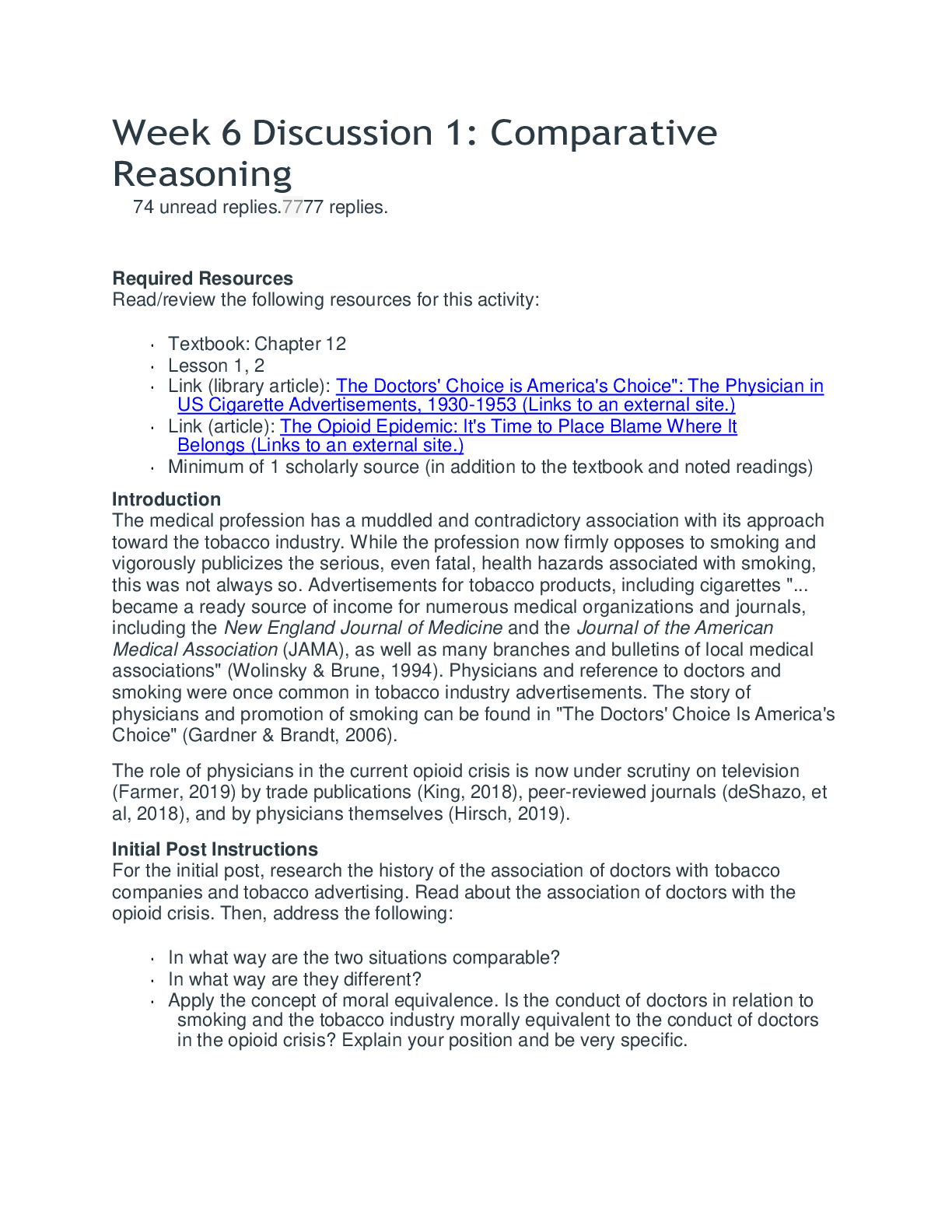
Also available in bundle (2)
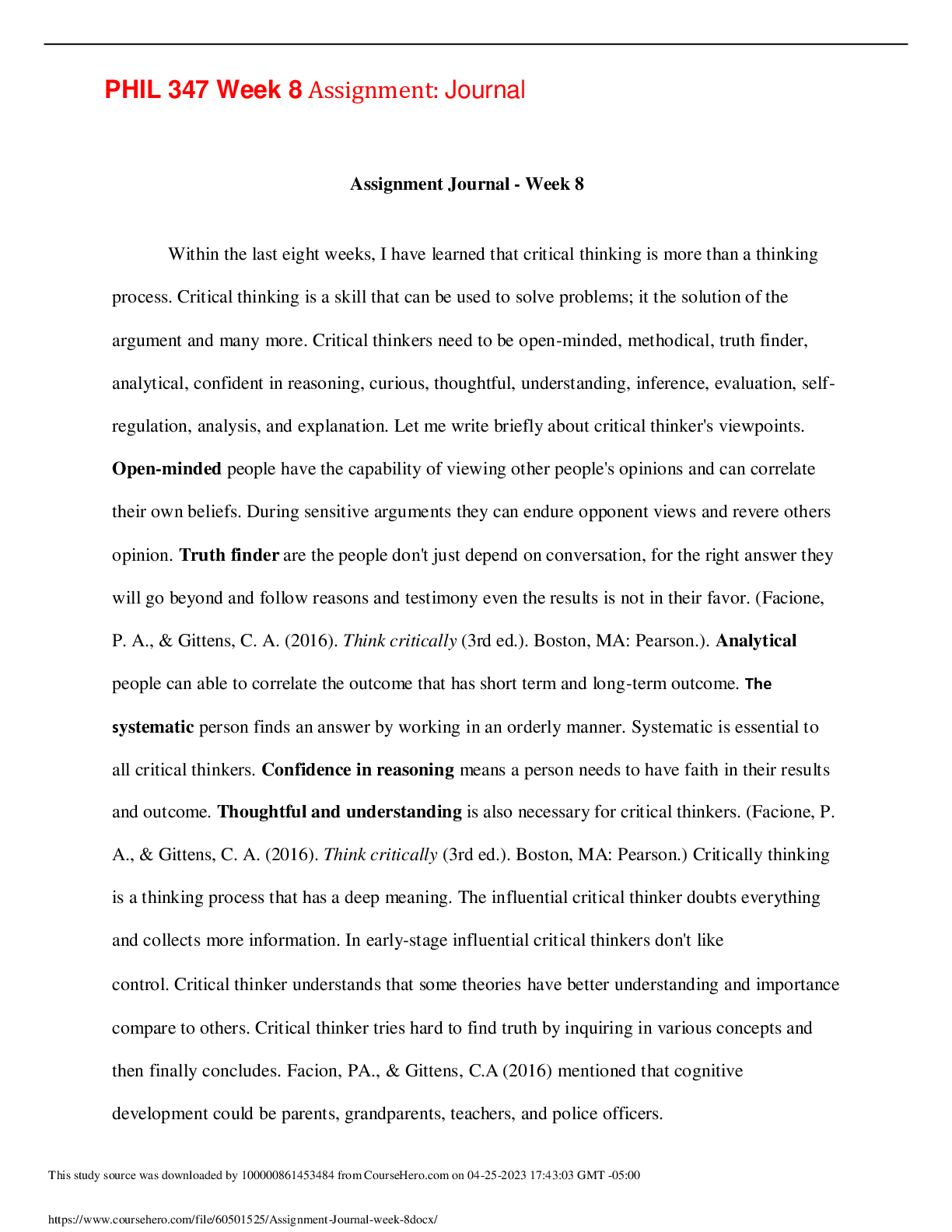
PHIL 347 PACKAGE DEAL - DOWLOAD TO SCORE AN A+
PHIL 347 Week 8 Assignment: Journal - Download Paper For An A PHIL 347N Week 6 Discussion 2 Empirical Reasoning PHIL 347 Week 6 Discussion 1: Comparative Reasoning- Download Paper To Get A Pass...
By Doc.Mukai Edyth 2 months ago
$30
19

PHIL 347 Package Deal Critical Reasoning
PHIL 347 Week 1 Assignment: Journal PHIL-347 Week 1 Course Project: Topic Selection PHIL 347 Week 2 Assignment: Journal PHIL-347 Week 3 Course Project: Issue Review PHIL 347 Week 4 Assignm...
By Doc.Mukai Edyth 10 months ago
$25
10
Reviews( 0 )
Document information
Connected school, study & course
About the document
Uploaded On
Apr 24, 2023
Number of pages
74
Written in
Additional information
This document has been written for:
Uploaded
Apr 24, 2023
Downloads
0
Views
50

